Physical Address
304 North Cardinal St.
Dorchester Center, MA 02124
The principal function of the urinary system is the maintenance of water, electrolyte and acid–base homeostasis , which requires that any input into the system is balanced by an equivalent output. The kidney provides the mechanism by which excess water and electrolytes are eliminated from the body, while the ureters , bladder and urethra form the storage and outflow tract. A second major function of the urinary system is the excretion of many toxic metabolic waste products, particularly the nitrogenous molecules urea and creatinine, compounds that can conveniently be excreted dissolved in water. The end product of these processes is urine . Since all body fluids are maintained in dynamic equilibrium with one another by the circulatory system, any adjustment in the composition of the blood results in similar changes in the other fluid compartments of the body. Thus regulation of the osmotic concentration of blood plasma by the kidneys ( osmoregulation ) ensures the osmotic regulation of all other body fluids. The third major function of the kidney is the maintenance of normal blood pressure.
The functional and structural unit of the kidney, the nephron , consists of a renal corpuscle (including the glomerulus ) plus a long, folded renal tubule . The human kidney contains approximately 1 million nephrons that perform the functions of osmoregulation and excretion by the following processes:
Filtration in the glomerulus of most small molecules from blood plasma to form an ultrafiltrate of plasma.
Selective reabsorption in the tubule of most of the water and some other molecules from the ultrafiltrate, leaving behind excess and waste materials to be excreted.
Secretion in the tubule of some excretory products directly from blood into the urine.
Maintenance of the acid–base balance by selective secretion by the tubule of H + ions into the urine.
The kidney also has hormonal and metabolic functions:
Renin , synthesised in the kidney, is a component of the renin–angiotensin–aldosterone mechanism that controls blood pressure.
Erythropoietin , synthesised in the kidney, stimulates the production of erythrocytes in the bone marrow and thus regulates the oxygen-carrying capacity of the blood.
Vitamin D , which regulates calcium balance, is converted to an active form in the kidney.
C cortex Cp capsule H hilum M medulla P papilla U ureter
Renal failure occurs for a variety of reasons and may be acute or chronic. Irreversible severe renal failure is inevitably fatal unless some form of renal replacement therapy is undertaken. Current options for renal replacement therapy include renal dialysis and renal transplantation. Dialysis may take the form of haemodialysis or, less commonly, peritoneal dialysis. Renal transplantation requires a donor, which can often involve a long wait until a suitable HLA-compatible donor is found. Those individuals lucky enough to have a compatible and willing family member are able to receive a donated kidney from them. This highlights the inbuilt redundancy of the kidneys whereby an individual can survive and be perfectly healthy with only one kidney. Stem cell research may in future provide a third option for renal replacement, the possibility of growing one’s own perfectly matched new kidney (or heart or pancreas) from one’s own stem cells.
AA arcuate artery Ai interlobar artery AV arcuate vein C calyx Cx cortex G glomerulus IA interlobular artery MR medullary ray P renal pelvis RC renal corpuscle RP renal papilla T tubule U ureter V interlobular vein
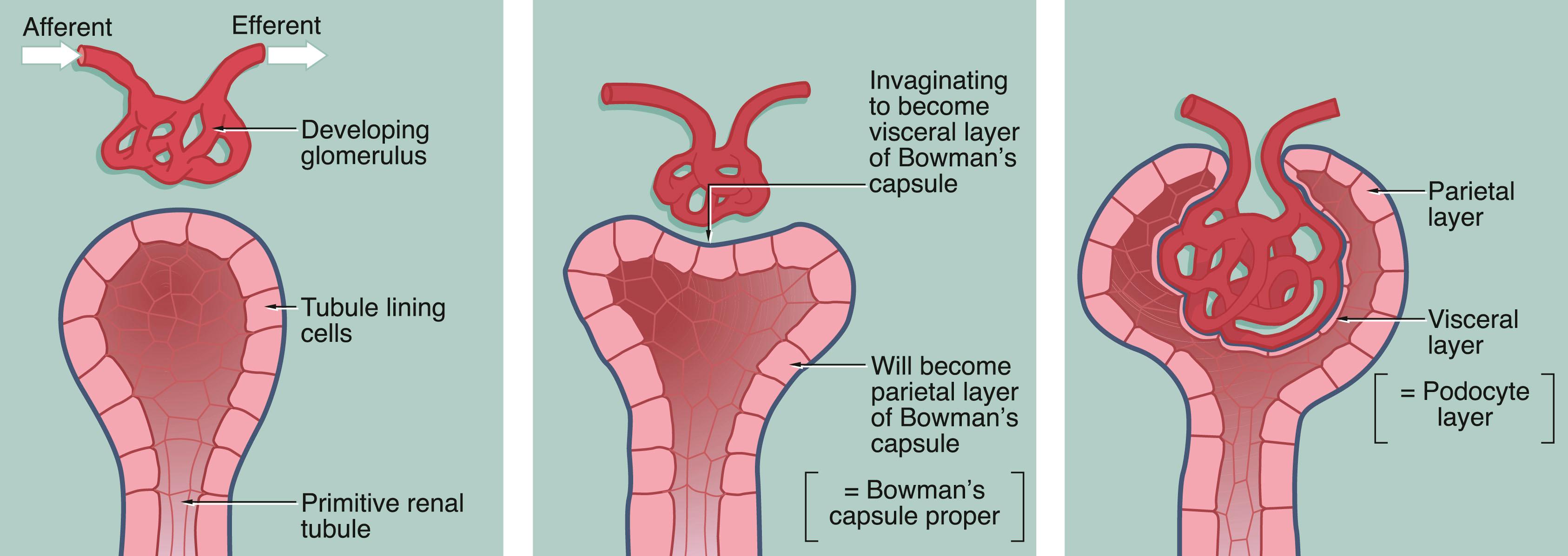
The renal cortex is easily identified even at low magnification by the presence of renal corpuscles, which are absent in the renal medulla. However, the bulk of the cortex is occupied by the proximal and distal convoluted tubules. The arcuate arteries and veins help to demarcate the cortex from the medulla.
A afferent arteriole BC Bowman’s capsule BS Bowman’s space C glomerular capillary E endothelial cell GBM glomerular basement membrane I interstitium M mesangium N mesangial cell nucleus P podocyte PCT proximal convoluted tubule S parietal epithelial cell
AA afferent arteriole BS Bowman’s space EA efferent arteriole G glomerulus IA interlobular artery N podocyte nucleus P 1 podocyte primary process P 2 podocyte secondary process RT renal tubule
BC Bowman’s capsule BM glomular basement membrane BS Bowman’s space C capillary loop E endothelial cell F fenestration FS filtration slit IPS interpodocyte space M mesangial cell MM mesangial matrix P podocyte P 1 podocyte primary process P 2 podocyte secondary foot process SPS subpodocyte space
Diabetic nephropathy is the most common cause of renal failure in affluent countries . The incidence of type 2 diabetes is increasing, an increase that is felt to be largely due to changing lifestyles, with increasing obesity and decreasing exercise, although there is little doubt that genetic factors are also important. Usually one of the earliest signs of diabetic nephropathy is proteinuria, which may eventually progress to the nephrotic syndrome and progressive chronic renal failure. The microscopic features in these cases include thickening of the mesangial basement membrane and an increase in mesangial matrix, often called diabetic glomerulosclerosis. In normal glomeruli, the balance between deposition of new and removal of old mesangial matrix is very tightly controlled. Recent research is beginning to tease out the mechanisms underlying these clinical features, including chemical mediators such as transforming growth factor β (TGF-β) that induce increased deposition of mesangial matrix in response to high glucose concentrations. This mesangial matrix has a different composition to normal matrix, including increased amounts of type I and type III collagen which are not easily removed from the glomerulus. However, other factors, including direct podocyte injury and changes in the slit pore membrane, also contribute to the characteristic proteinuria that precedes frank renal failure.
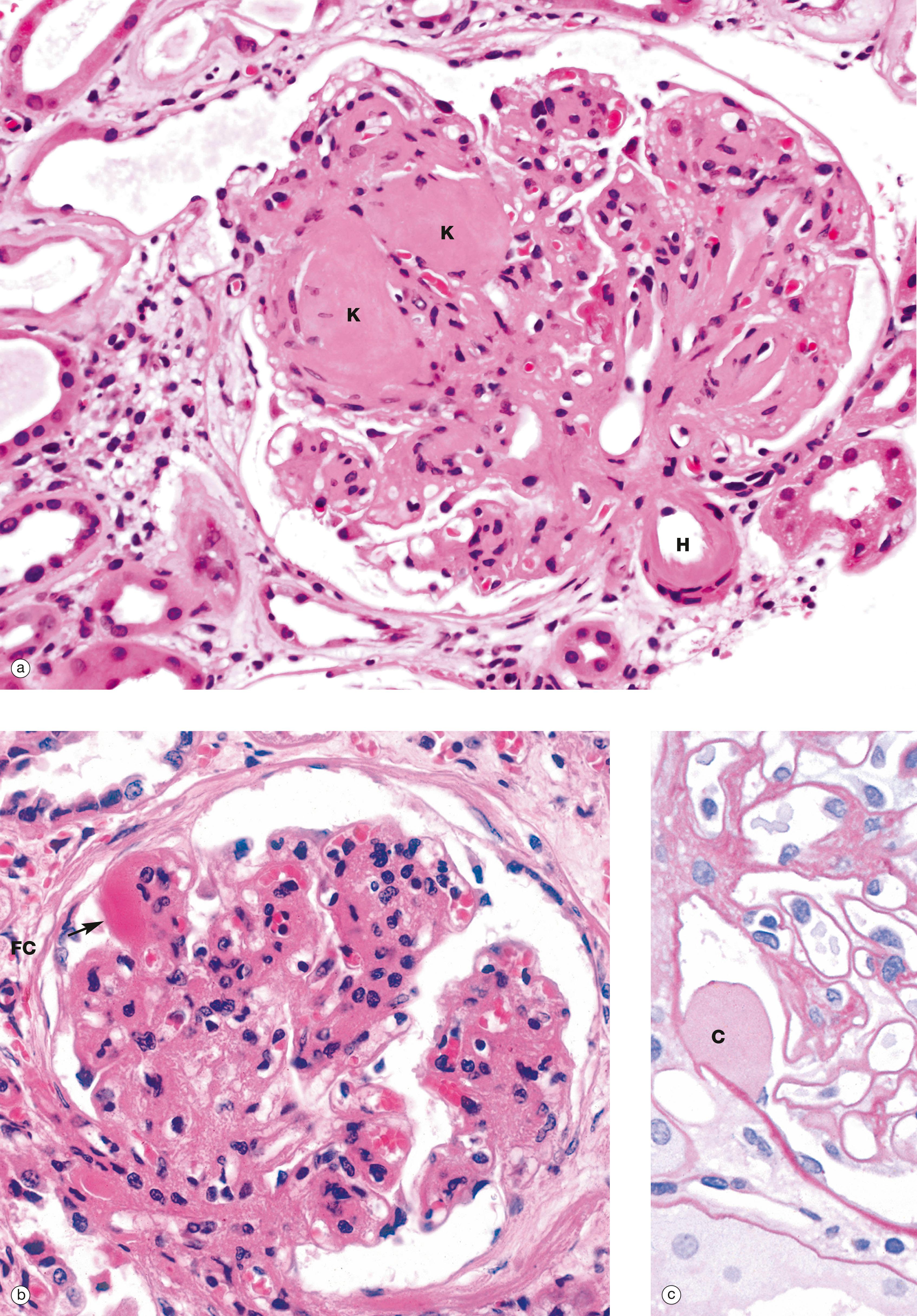
Diabetics also tend to suffer from vascular disease, hypertension and increased infections in the kidney, and all of these tend to contribute to the development of end-stage renal failure .
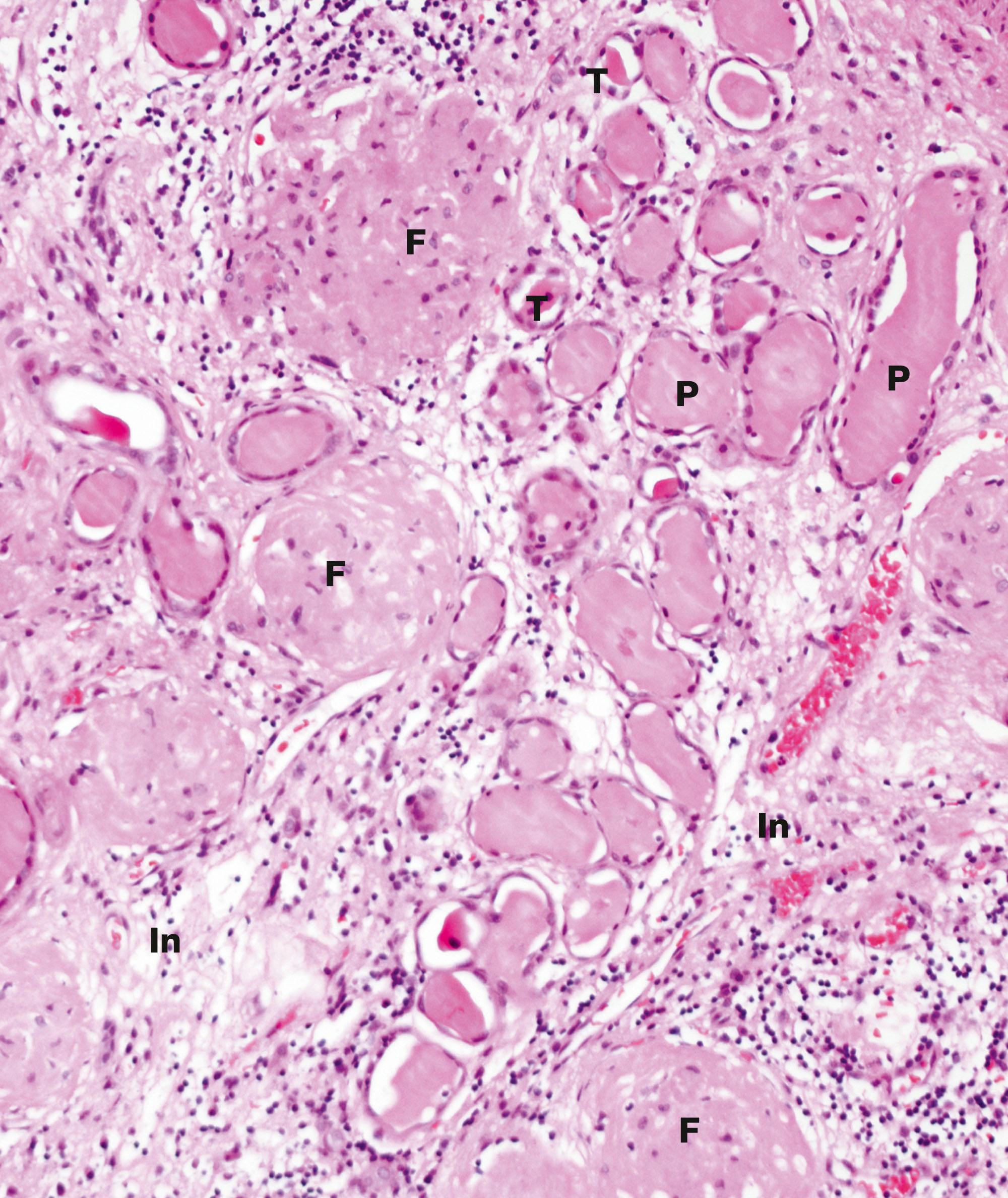
BB brush border BM basement membrane C peritubular capillaries CP mesangial cell cytoplasmic process DCT distal convoluted tubule E endothelial cell J cell junction L glomerular capillary lumen PCT proximal convoluted tubule MC mesangial cell MM mesangial matrix P 1 podocyte primary process P 2 podocyte secondary foot process SPS subpodocyte space
Damage to the renal tubules is a fairly common cause of acute renal failure. Acute tubular necrosis usually occurs due to a sudden drop in the blood supply to the kidney, for example due to severe dehydration or massive blood loss. The cells of the renal tubules are highly metabolically active and so they are very susceptible to damage when the blood supply is compromised. As noted above, this is particularly so for the cells of the proximal convoluted tubule as they have a very high oxygen requirement.
The tubular epithelial cells will often recover if the underlying cause is treated and the patient is supported effectively during the acute phase of their illness. Often, during the recovery phase, the patient will produce very large volumes of dilute urine ( polyuria ), highlighting the key role of the tubular epithelial cells in reabsorbing water from the glomerular ultrafiltrate . Careful management of fluid balance is critical during recovery.
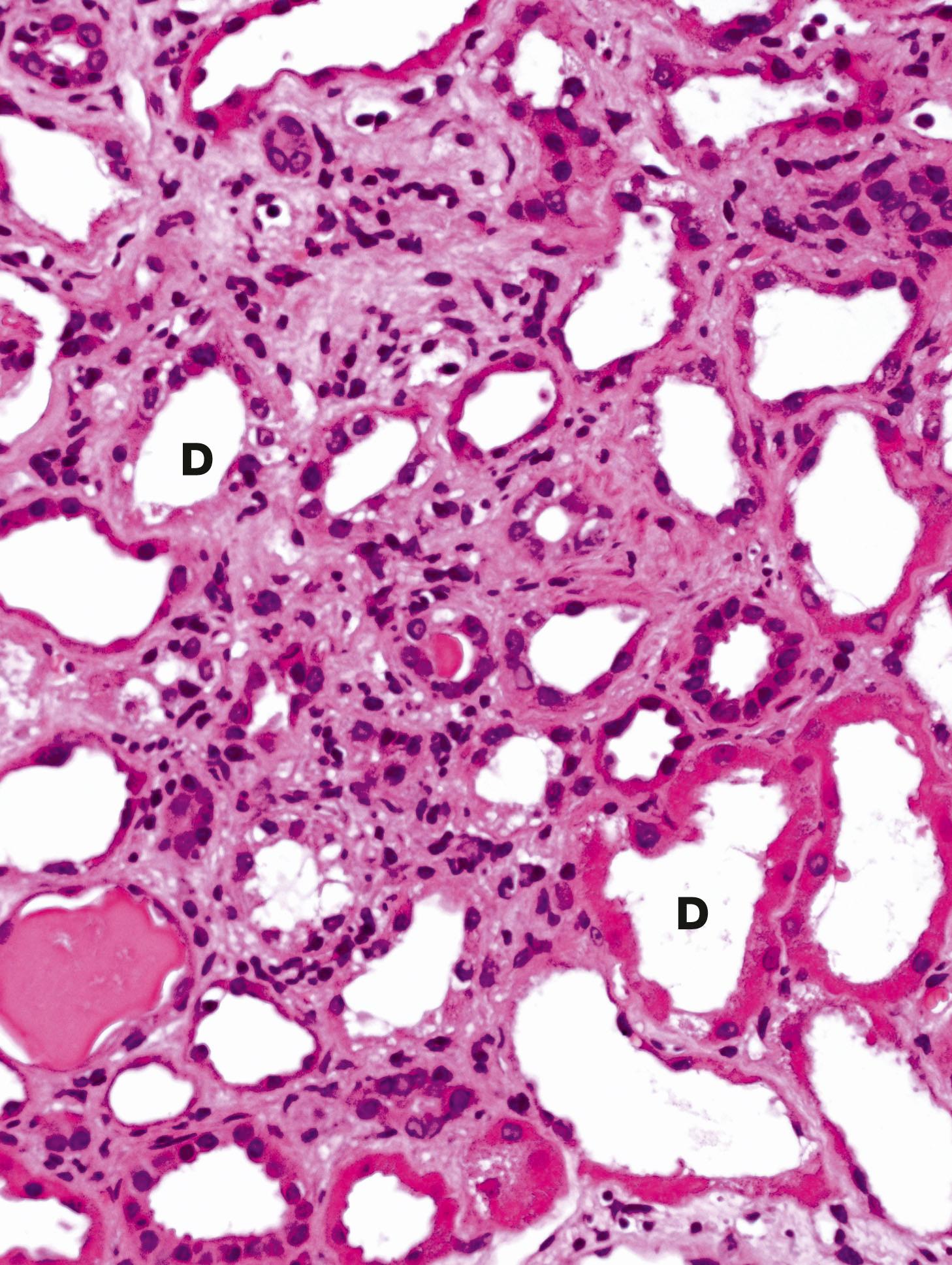
BM basement membrane BM E basement membrane of endothelium Cap capillary E endothelium J junctional complex L lysosome M mitochondrion Mv microvilli P cell process S supporting tissue V pinocytotic vesicle
AA afferent arteriole DCT distal convoluted tubule J juxtaglomerular cell L lacis cell MD macula densa
Hypertension is a common condition in middle-aged and elderly persons. Most cases are considered to be idiopathic (which simply means that the mechanism has not yet been elucidated). However, there are certainly genetic factors as well as lifestyle components underlying many, if not most, cases. A much smaller proportion of hypertensive patients, especially younger patients, have hypertension associated with renal disease. Many different types of renal disease may lead to hypertension; a classic example is the acute hypertension seen in patients with post-infectious glomerulonephritis. Many other chronic renal conditions, including diabetic nephropathy, IgA nephropathy and a range of other common conditions lead to secondary hypertension.
Conversely, hypertension can also lead to renal failure. The classic example of this is patients with accelerated hypertension who have acute renal failure with classic vascular changes in their renal biopsy at presentation. However, chronic untreated lower-level hypertension also typically leads to chronic renal damage in a pattern sometimes called ‘benign nephrosclerosis’, a misleading name as it can lead to chronic renal failure which may require renal replacement therapy.
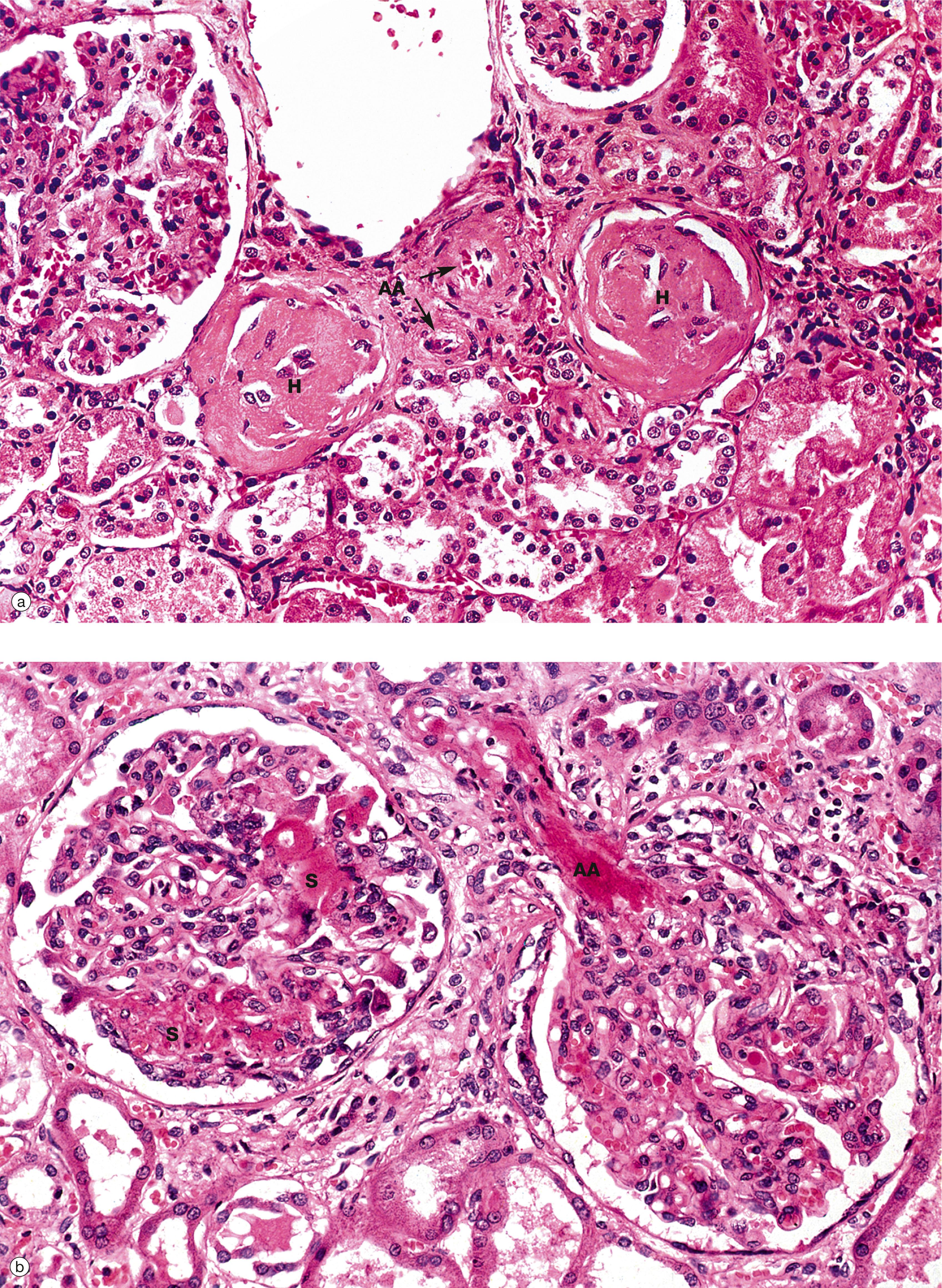
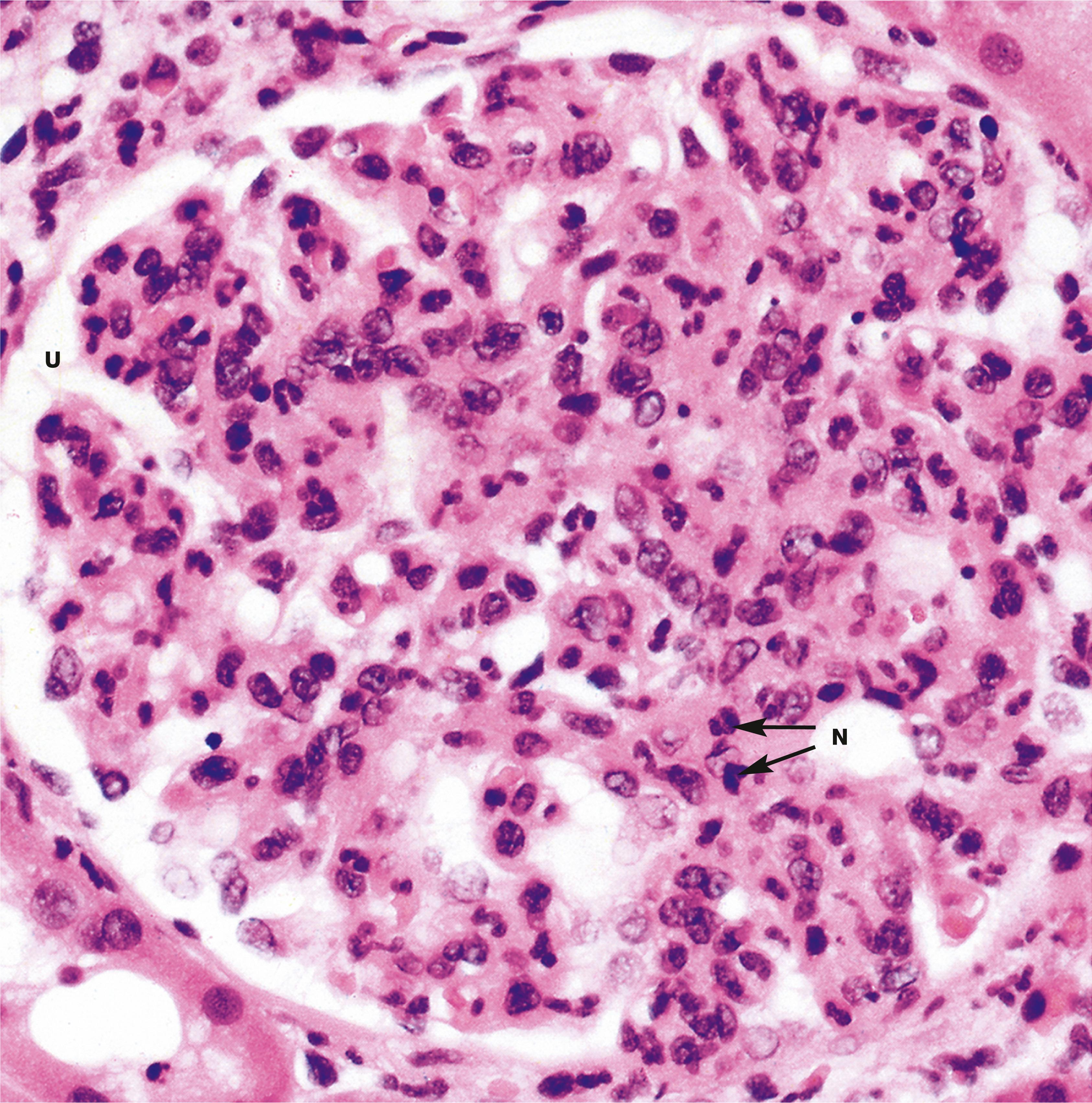
The renal medulla consists of closely packed tubules of two types: the loop of Henle and the collecting tubules and ducts, as well as the vasa recta. The loop of Henle is a continuation of the proximal convoluted tubule. It dips down into the medulla, where it loops back on itself and returns to the cortex to its own renal corpuscle, becoming the first part of the distal convoluted tubule.
A thick ascending limb of loop of Henle BM tubular basement membrane CD collecting duct CT collecting tubule IC intercalated cell S supporting tissue T thin limb of loop of Henle V vasa recta
BL basal lamina BM basement membrane C collagen fibrils CT collecting tubule D lipid droplet H loop of Henle L leukocyte N nucleus of interstitial medullary cell P cytoplasmic process of interstitial medullary cell S supporting tissue V vasa recta
The lower urinary tract includes the renal pelvis and calyces, the ureters, the urinary bladder and the urethra. The lower urinary tract is specialised for the storage and excretion of urine at a convenient time; no further modification of the urine is possible after it leaves the renal medulla.
A adventitia C circular muscle layer DB duct of Bellini E transitional epithelium IL inner longitudinal muscle layer of bladder L longitudinal muscle layer of ureter LP lamina propria OL outer longitudinal muscle layer of bladder PCS pelvicalyceal space SM smooth muscle U ureter Um umbrella cell V blood vessel
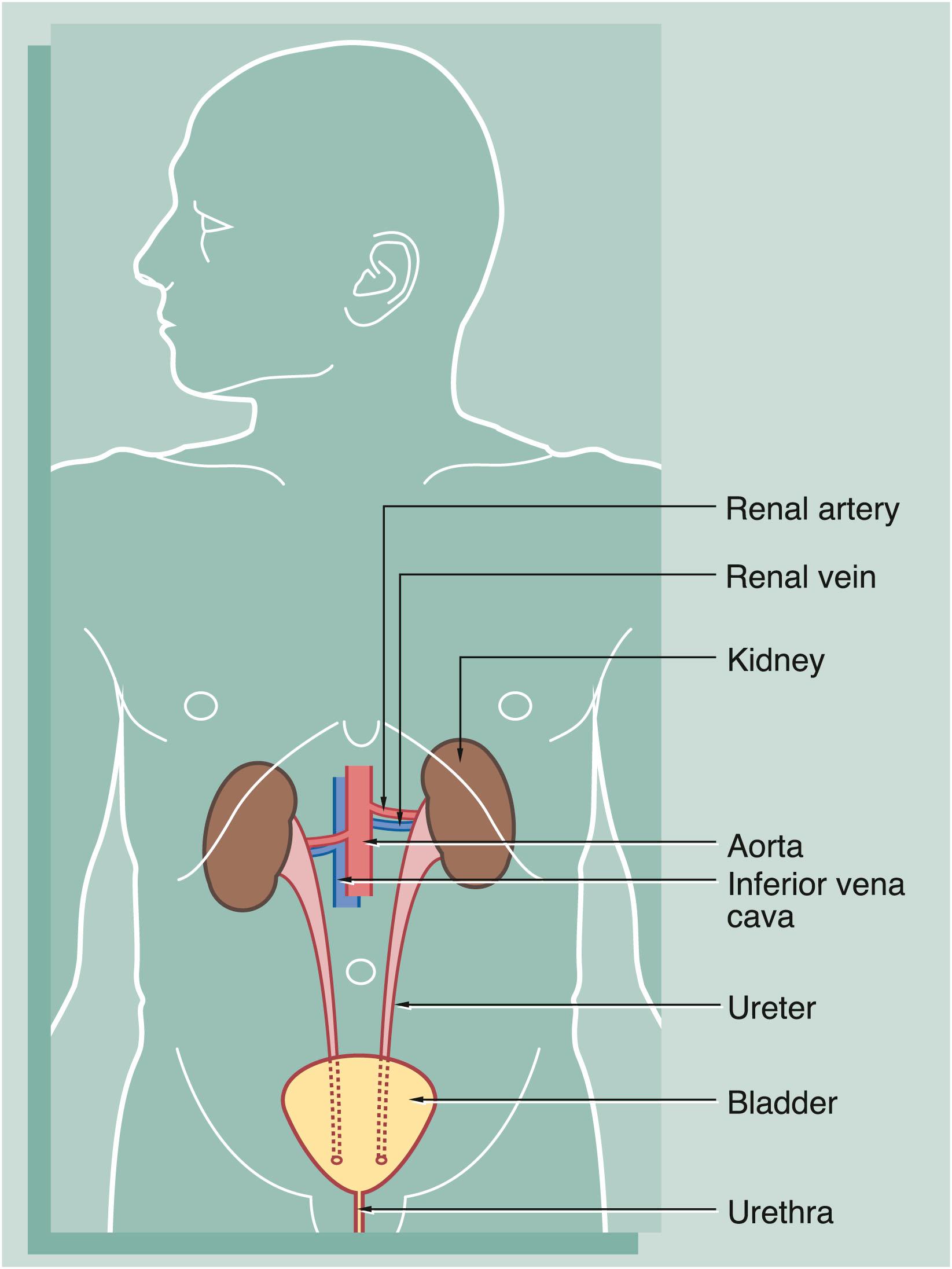

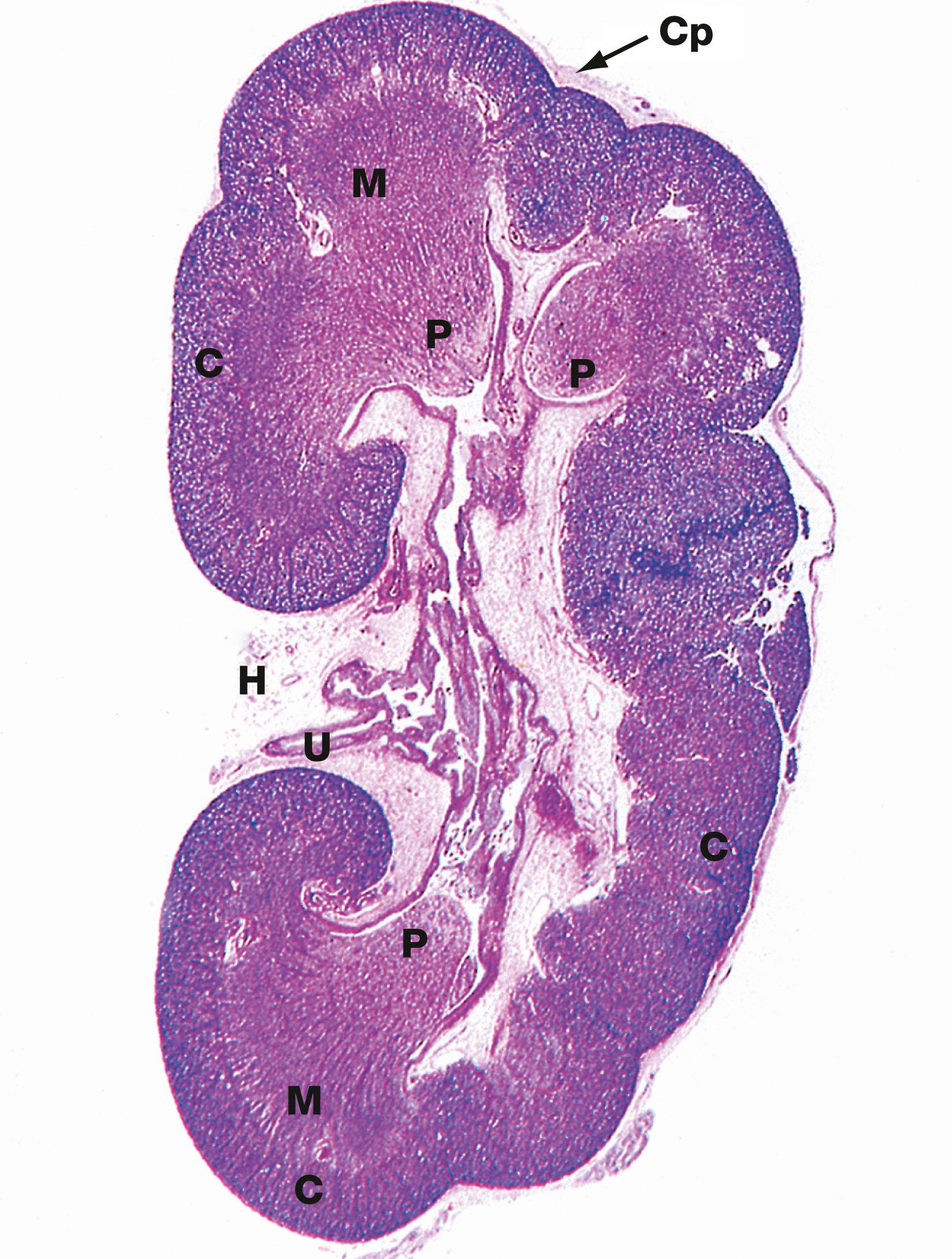
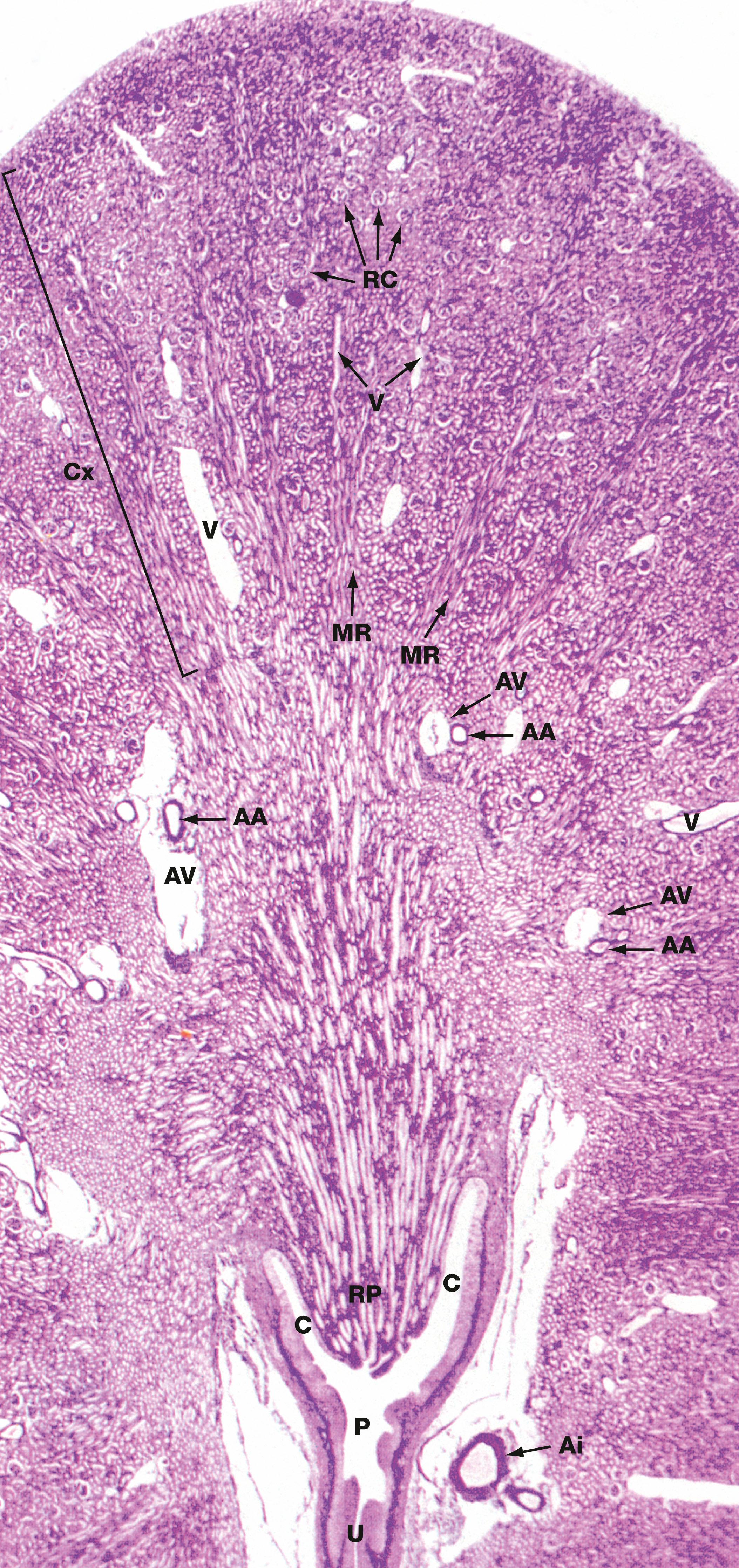
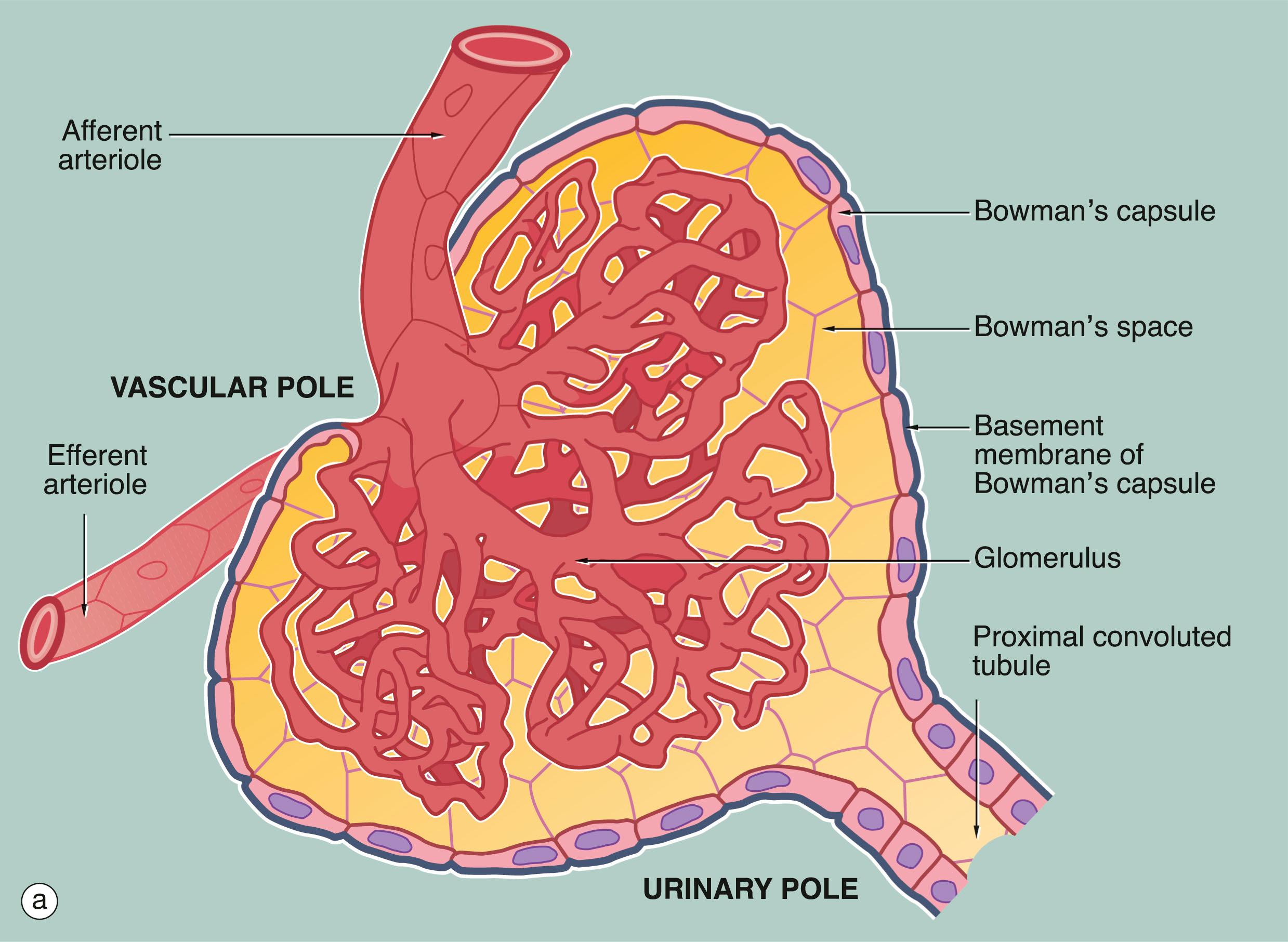
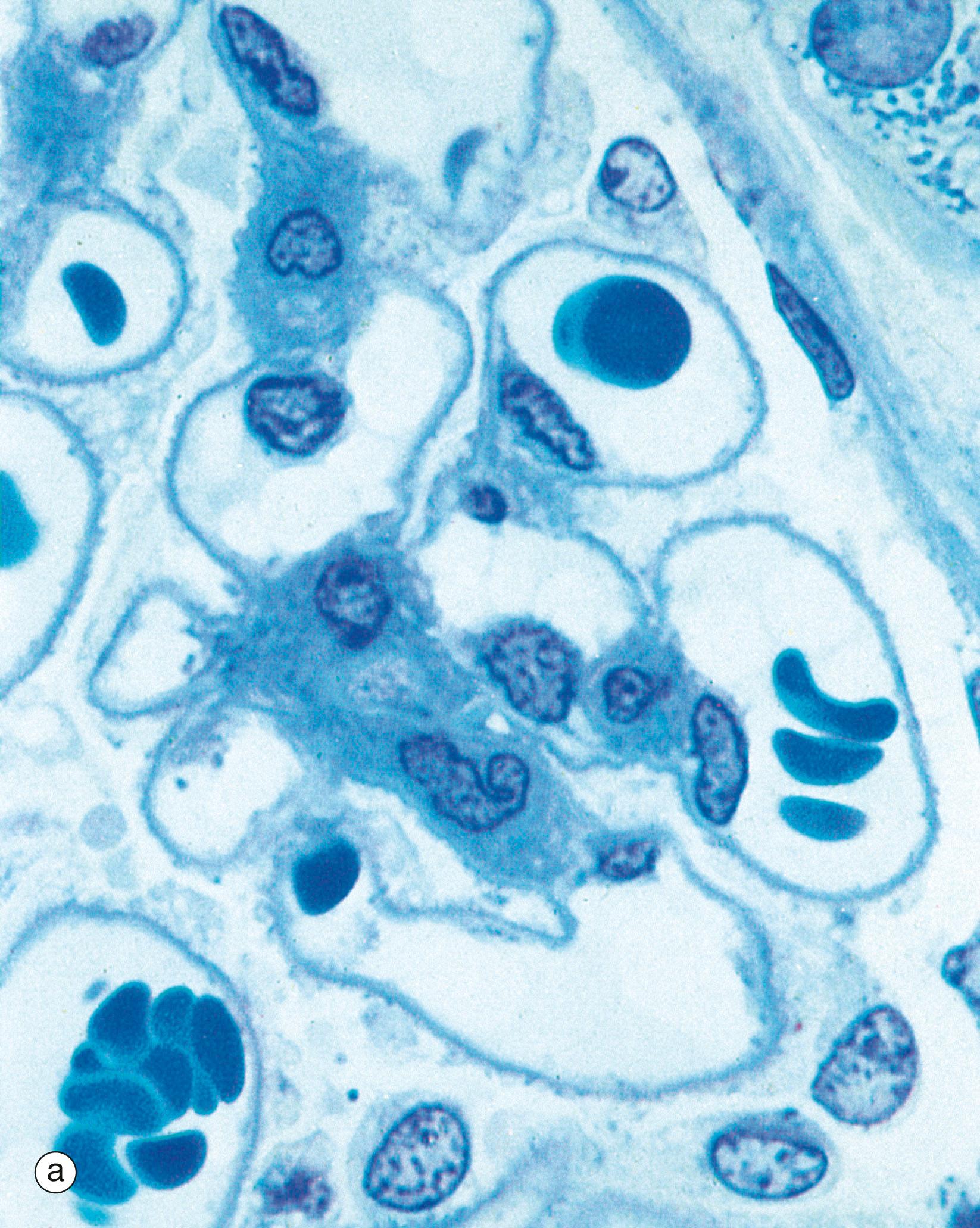
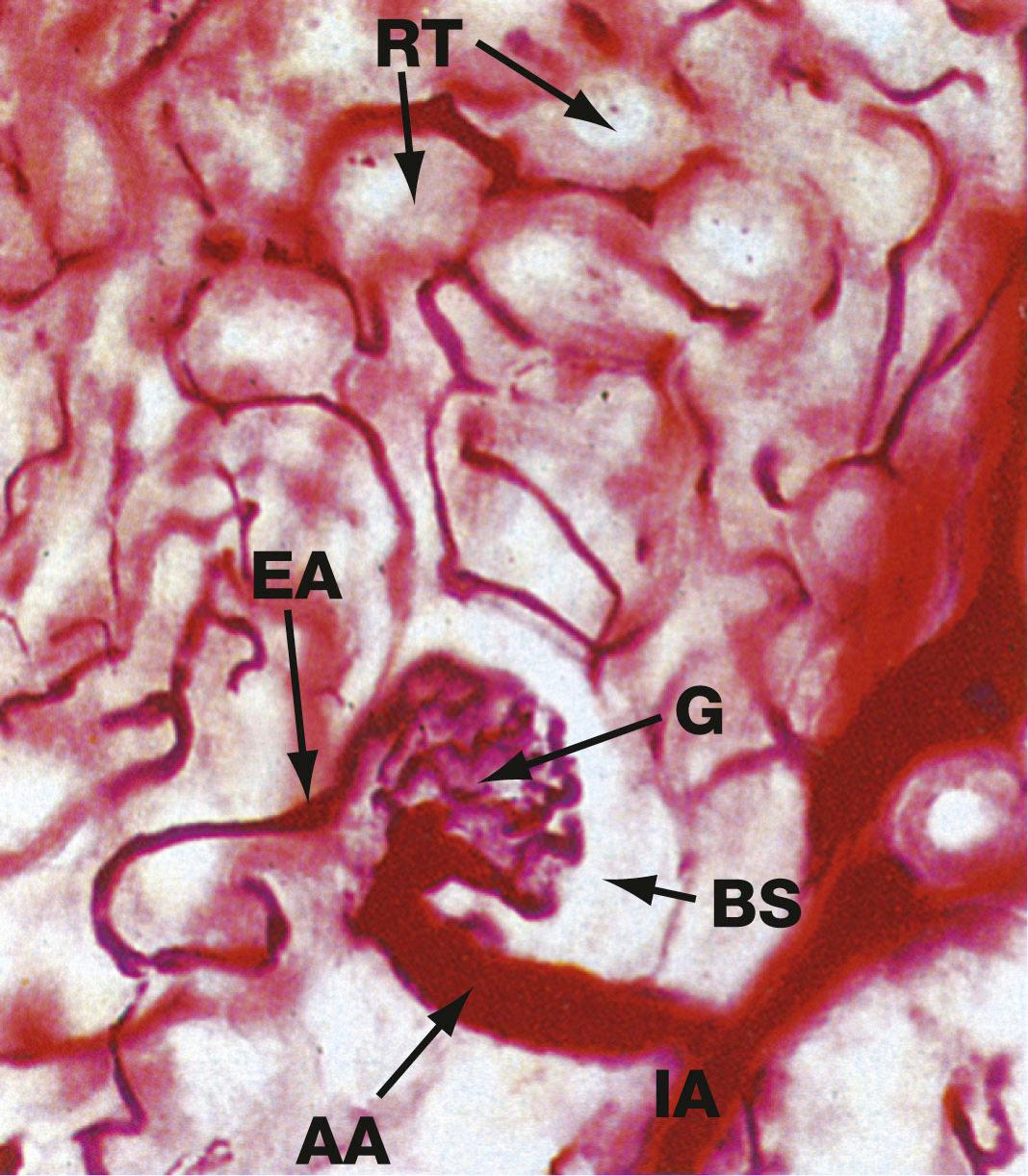
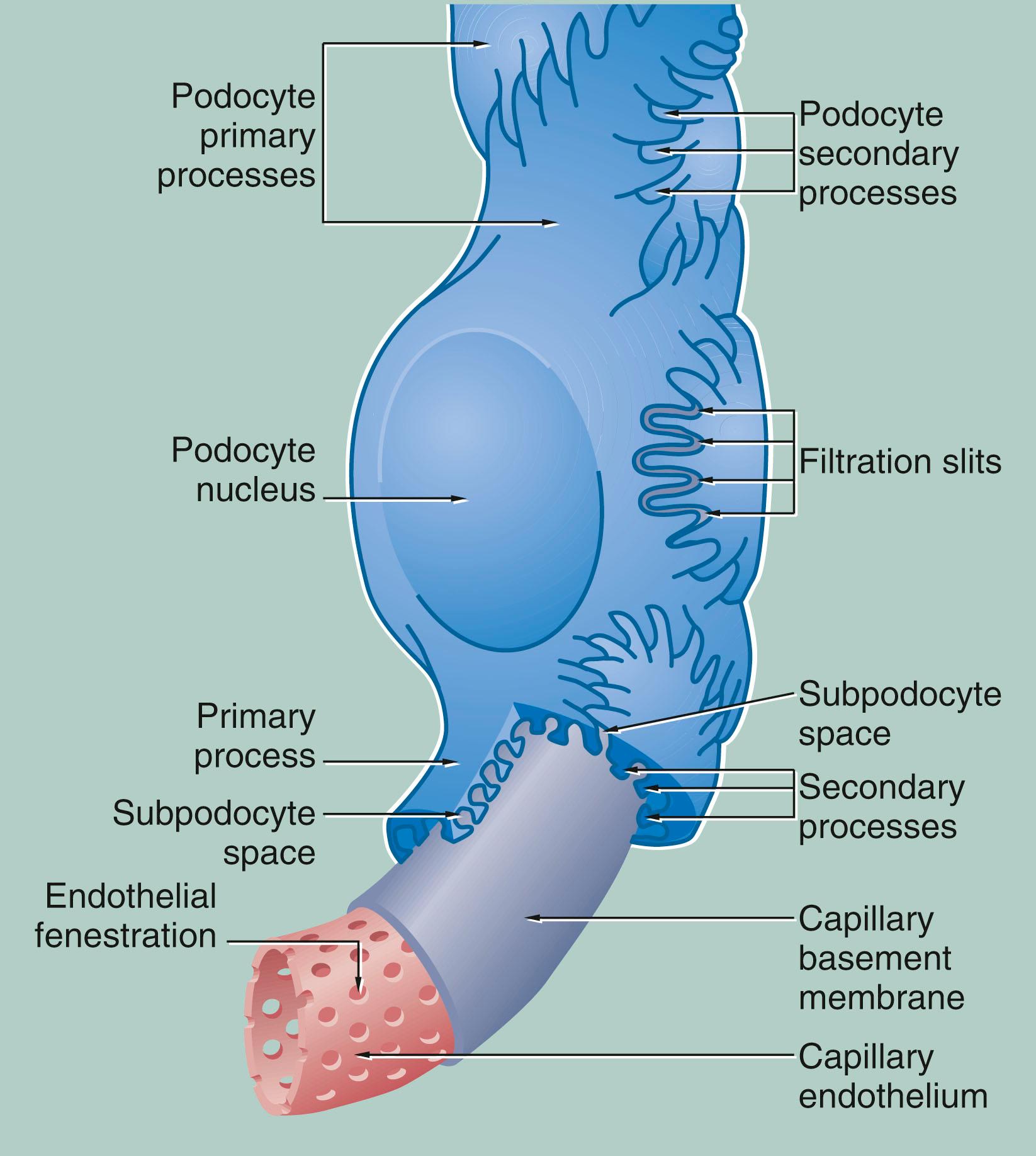
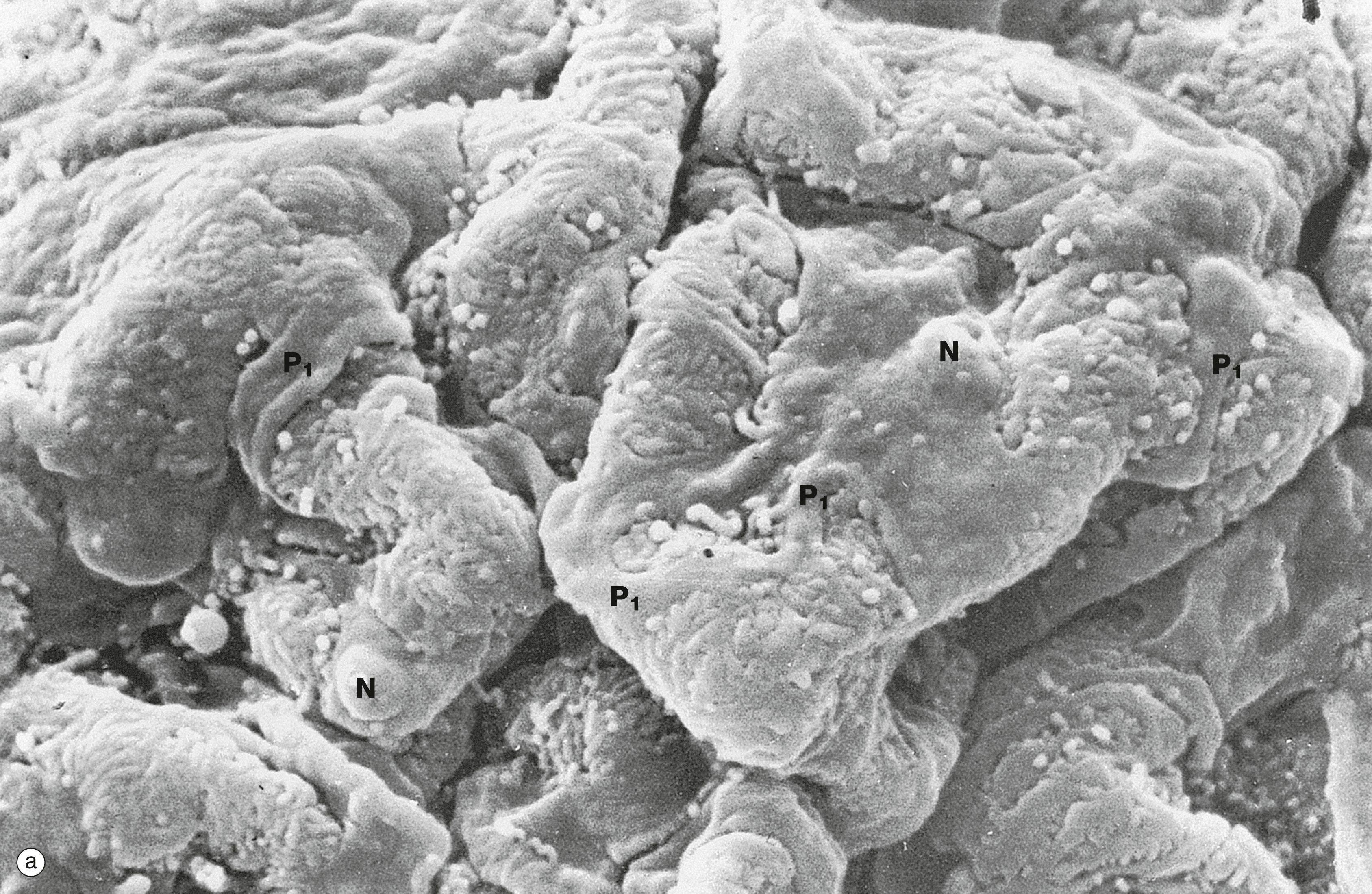
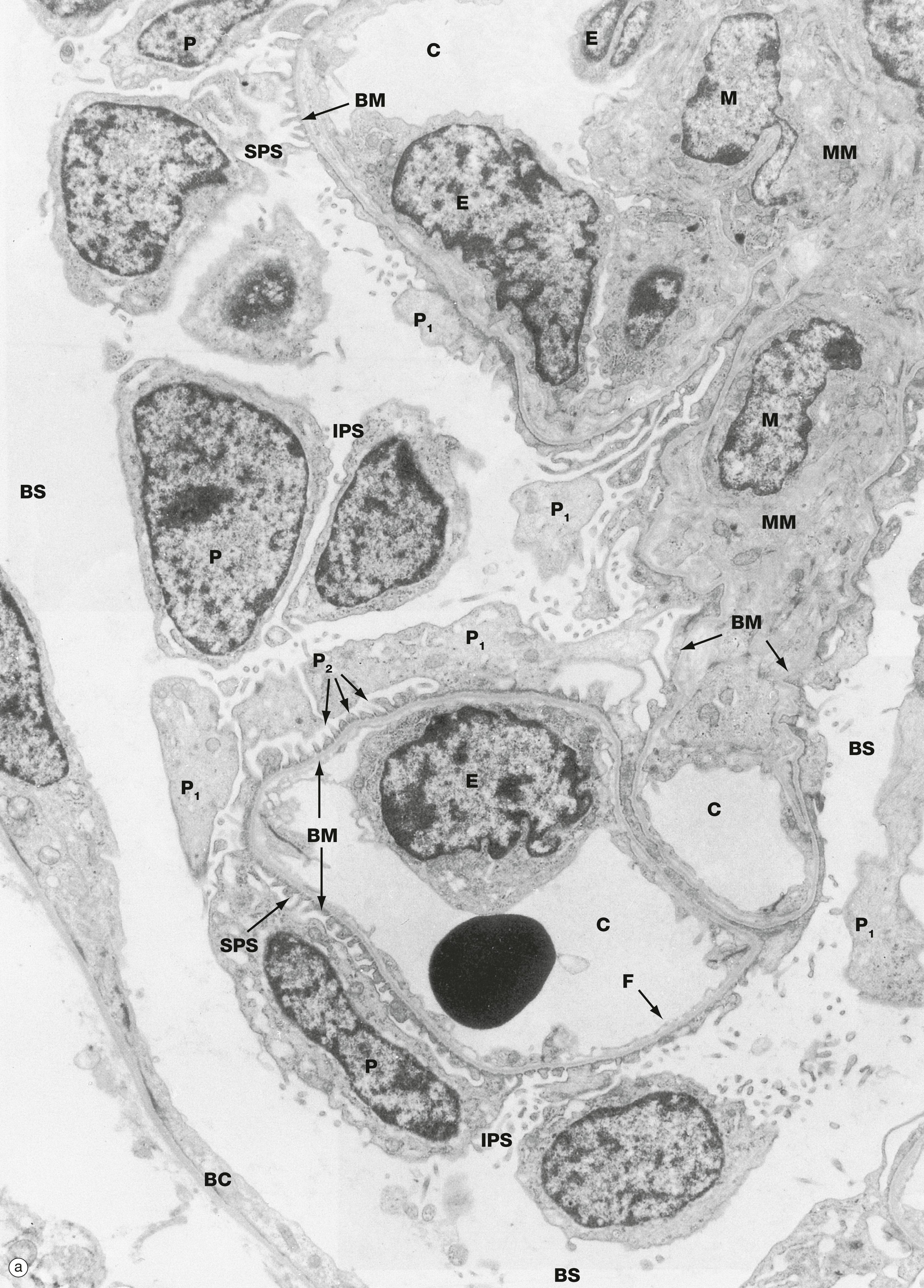
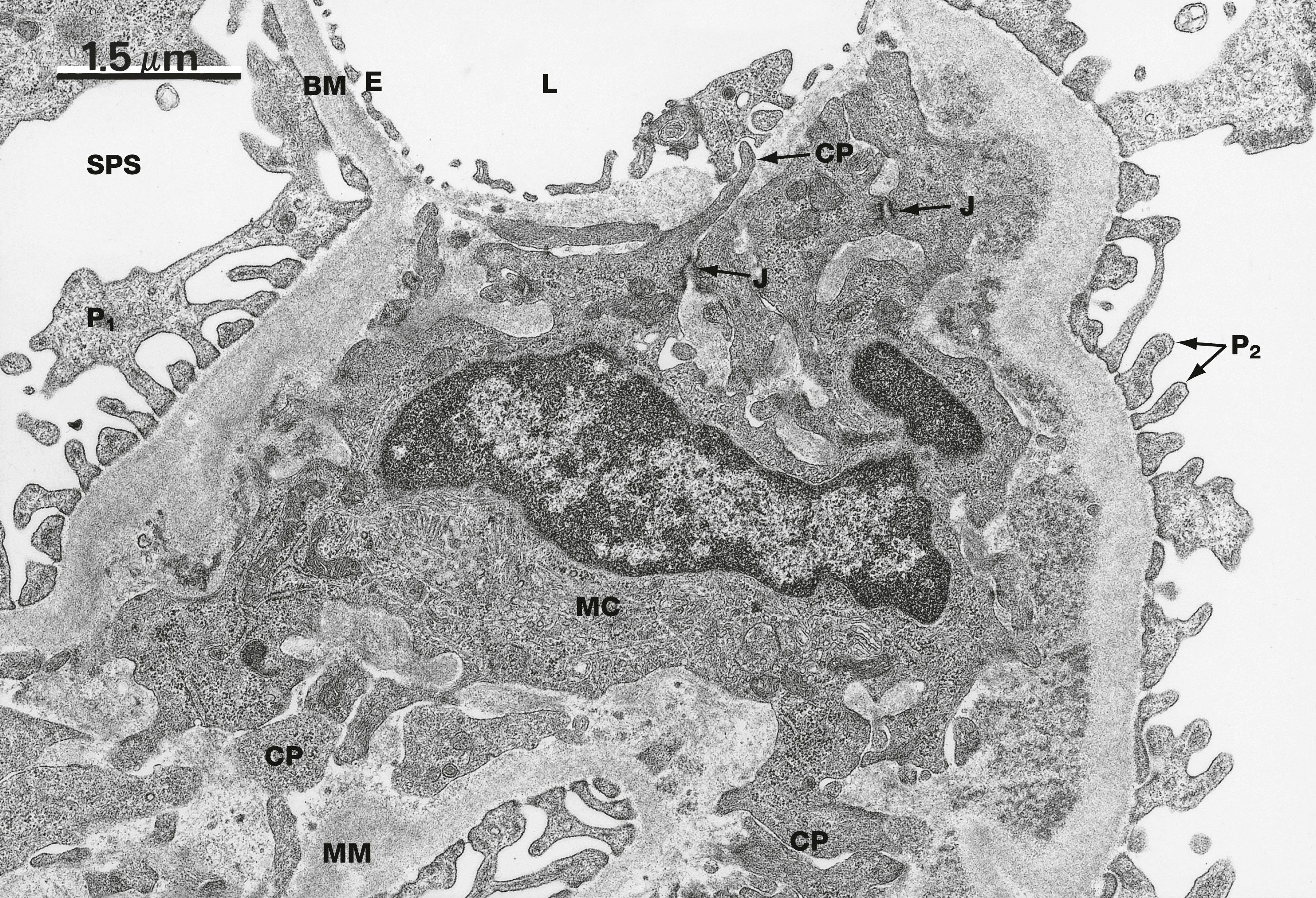
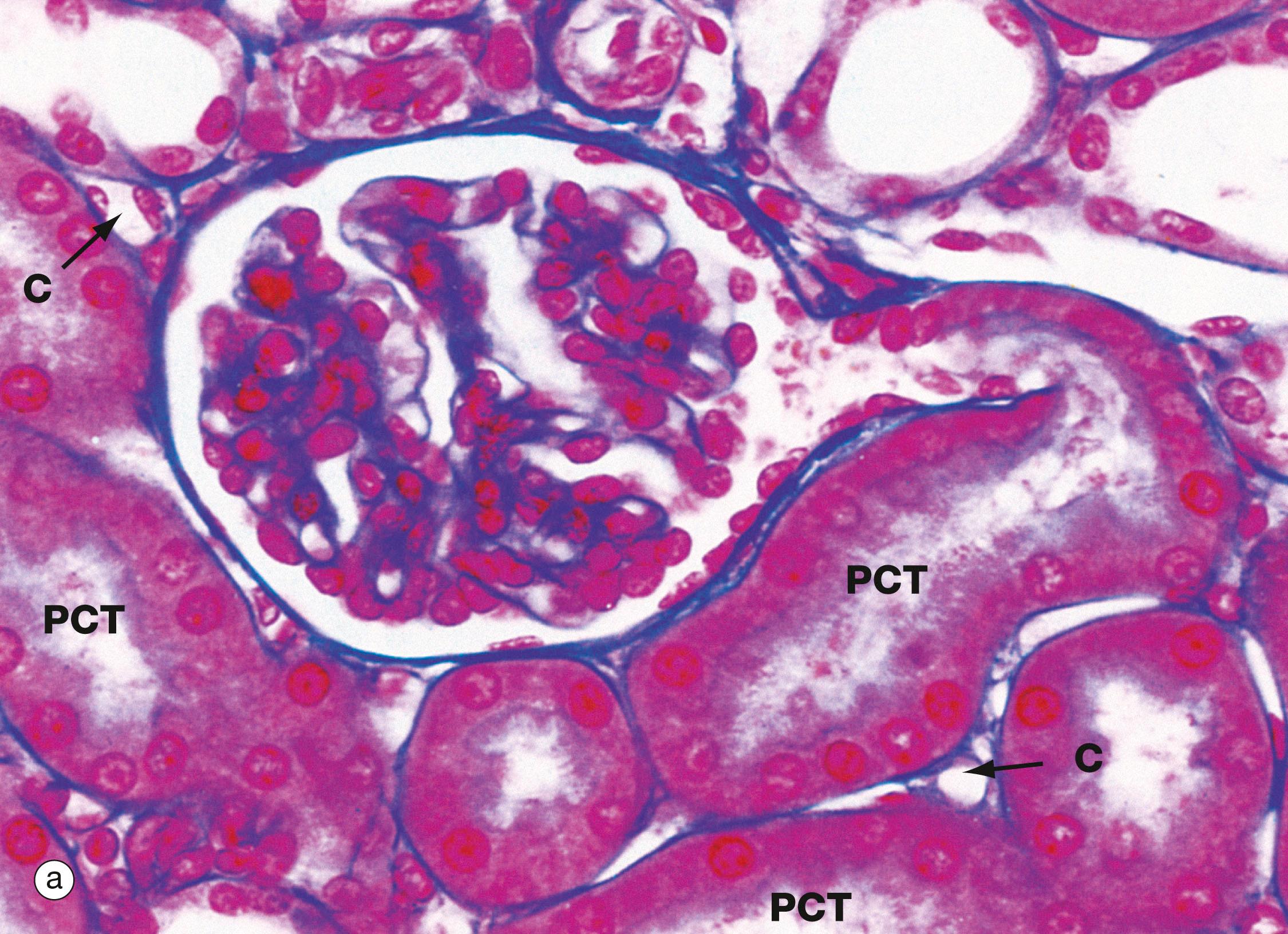
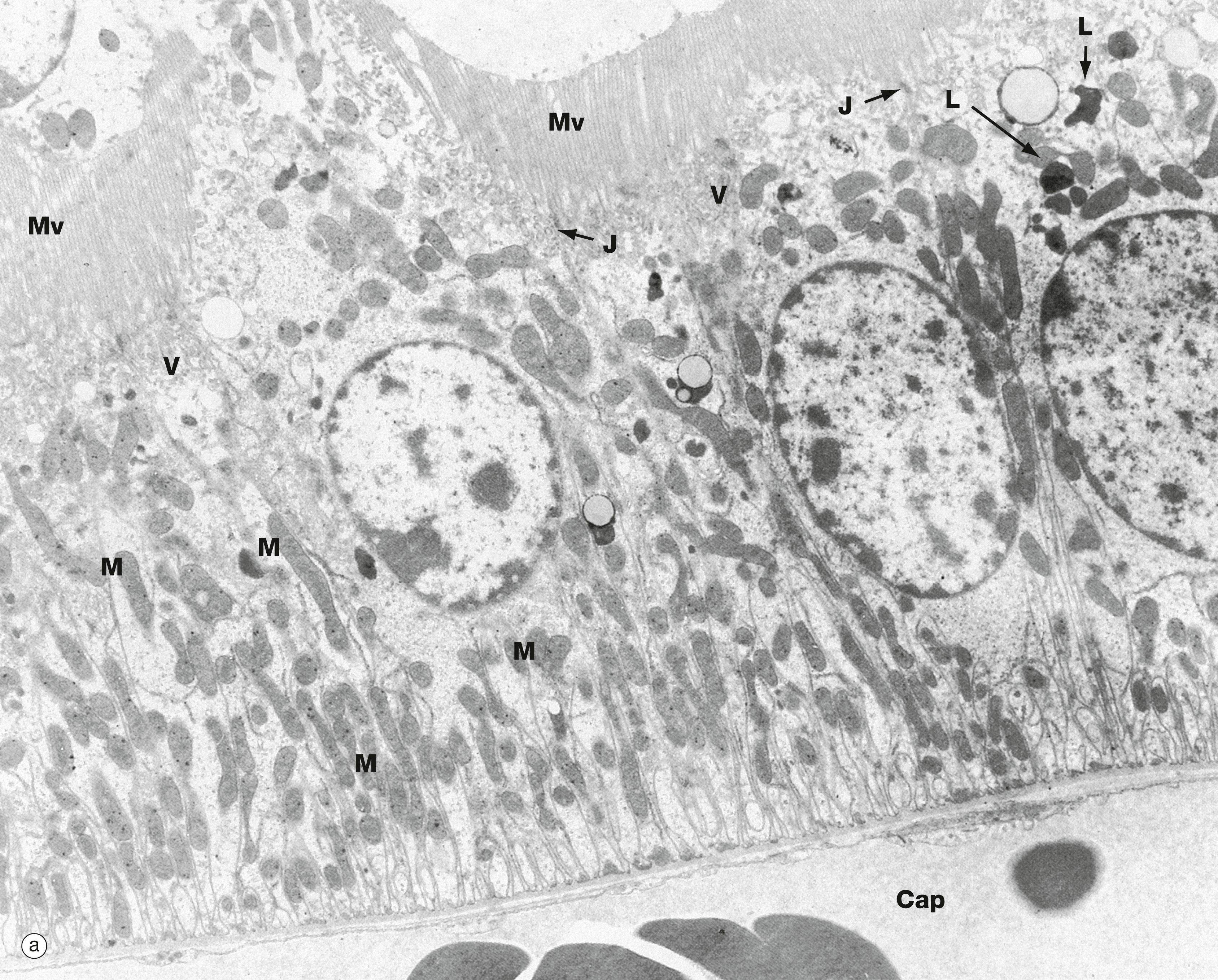
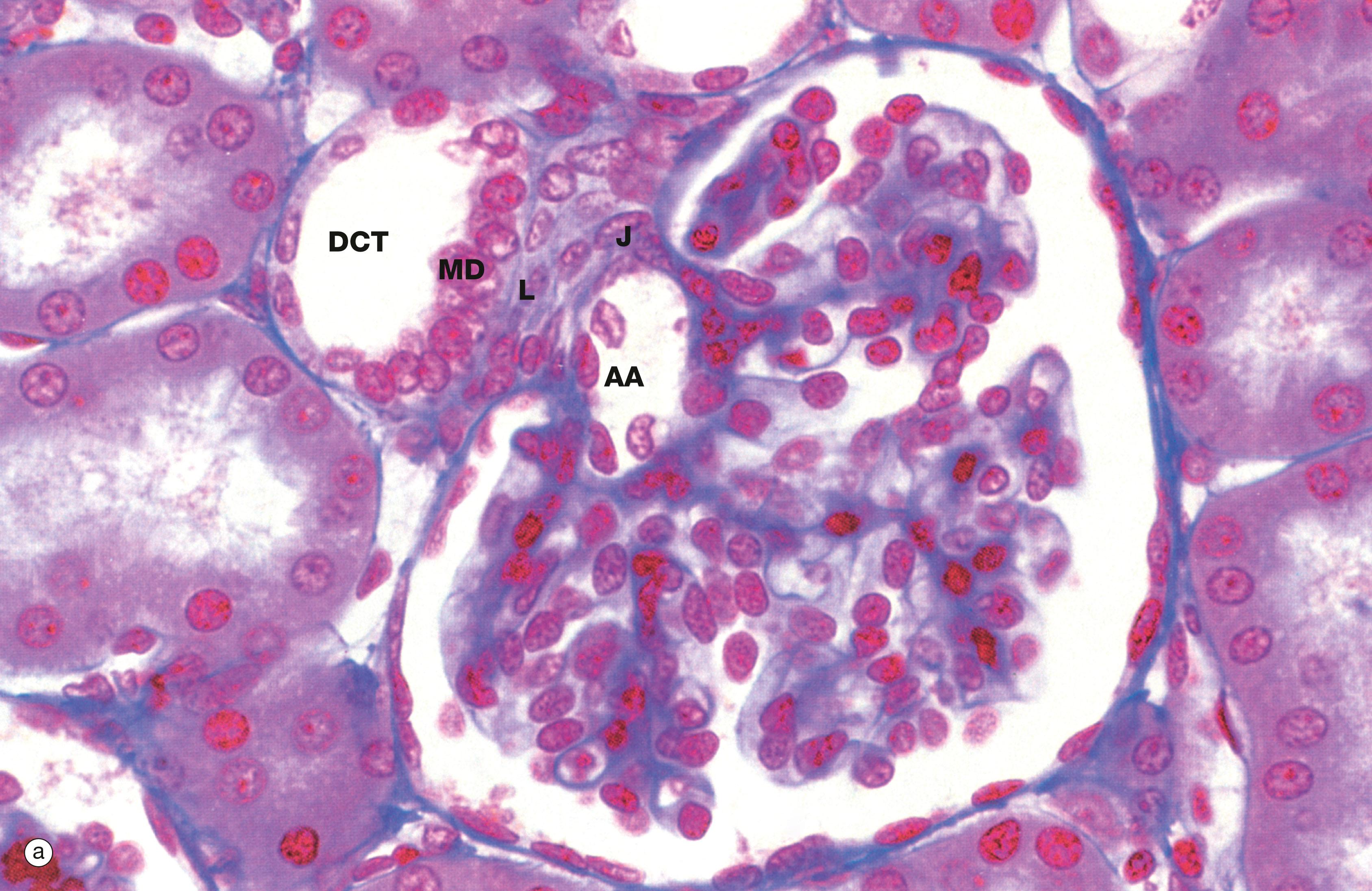
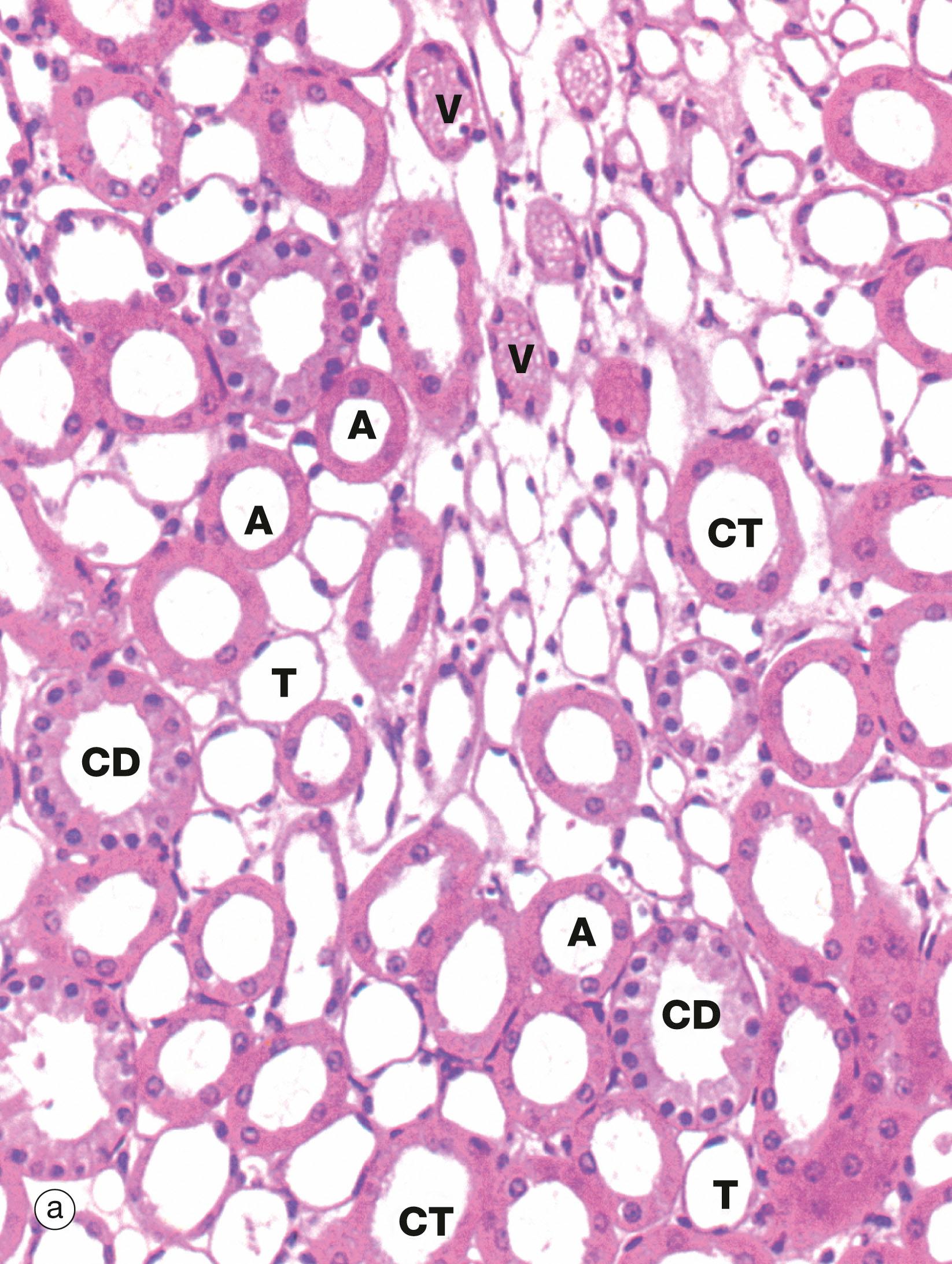
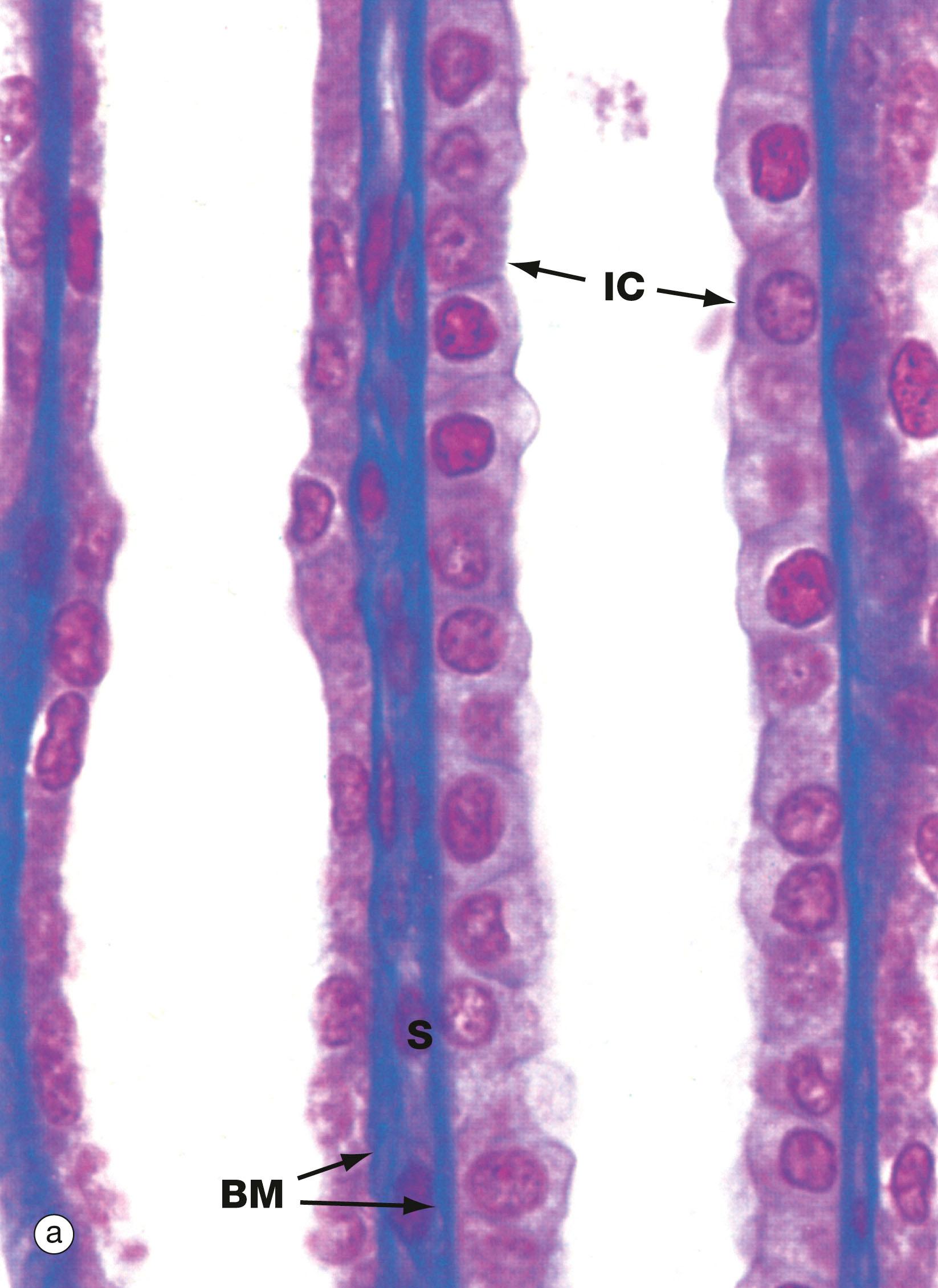
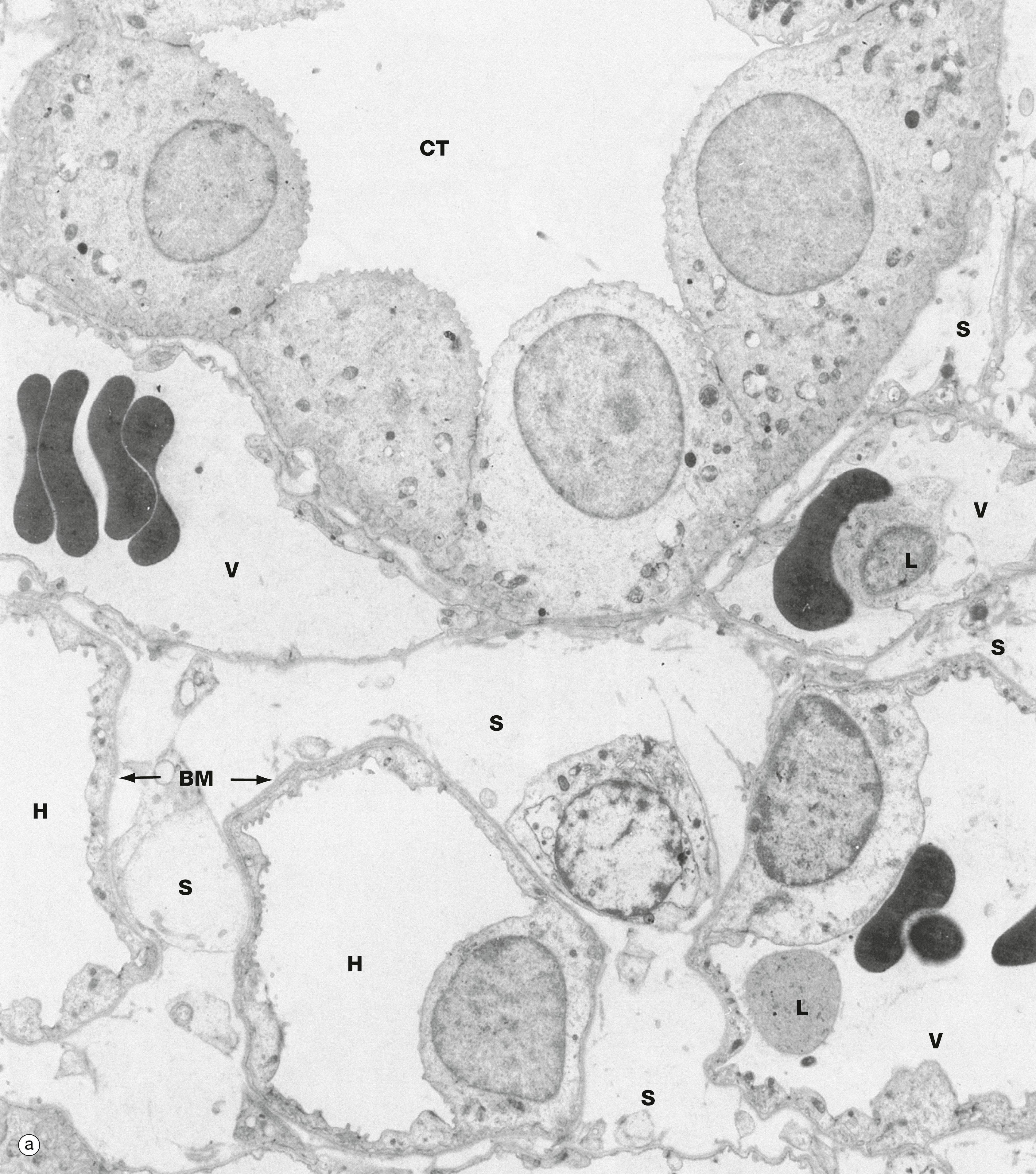
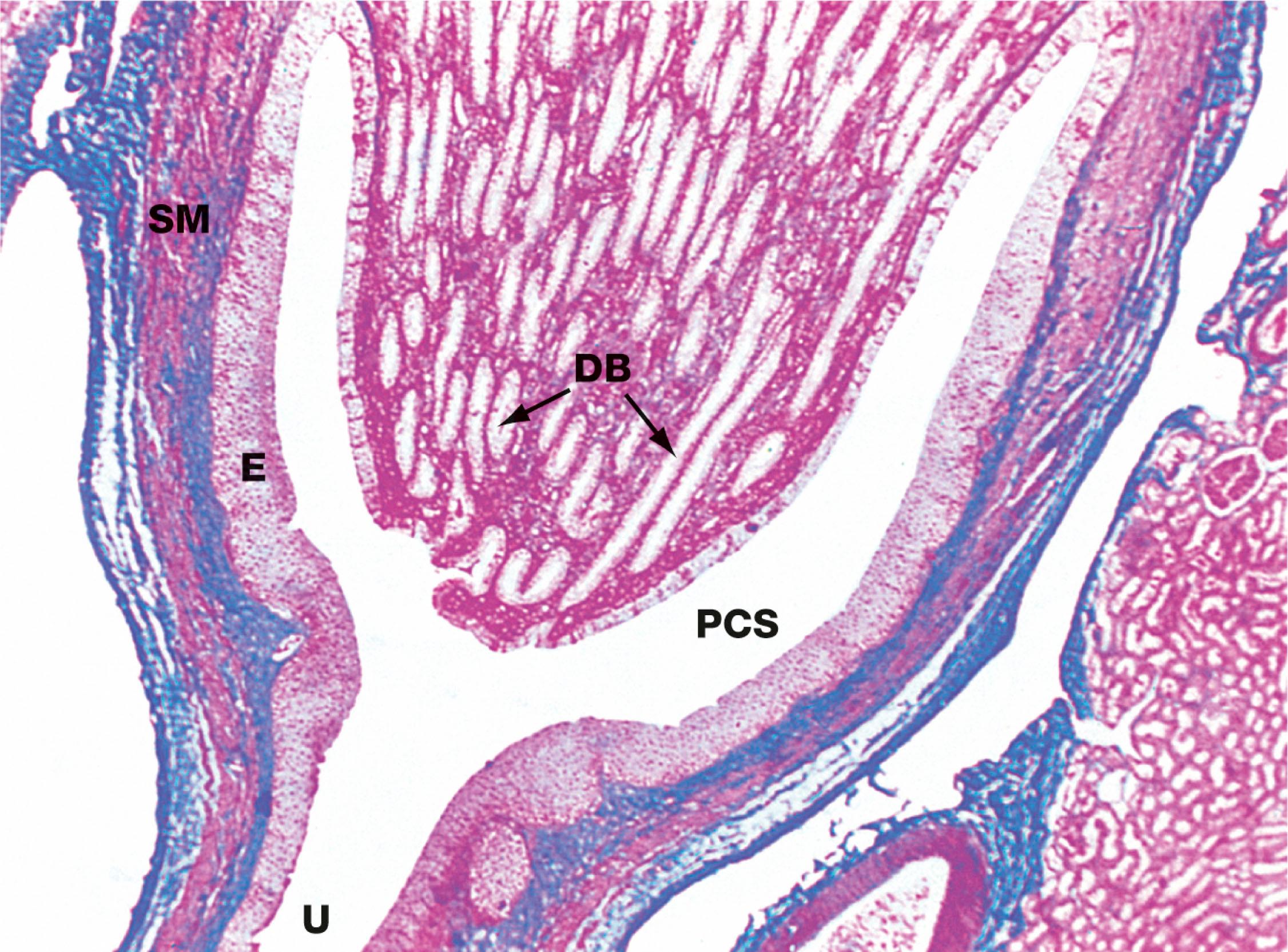
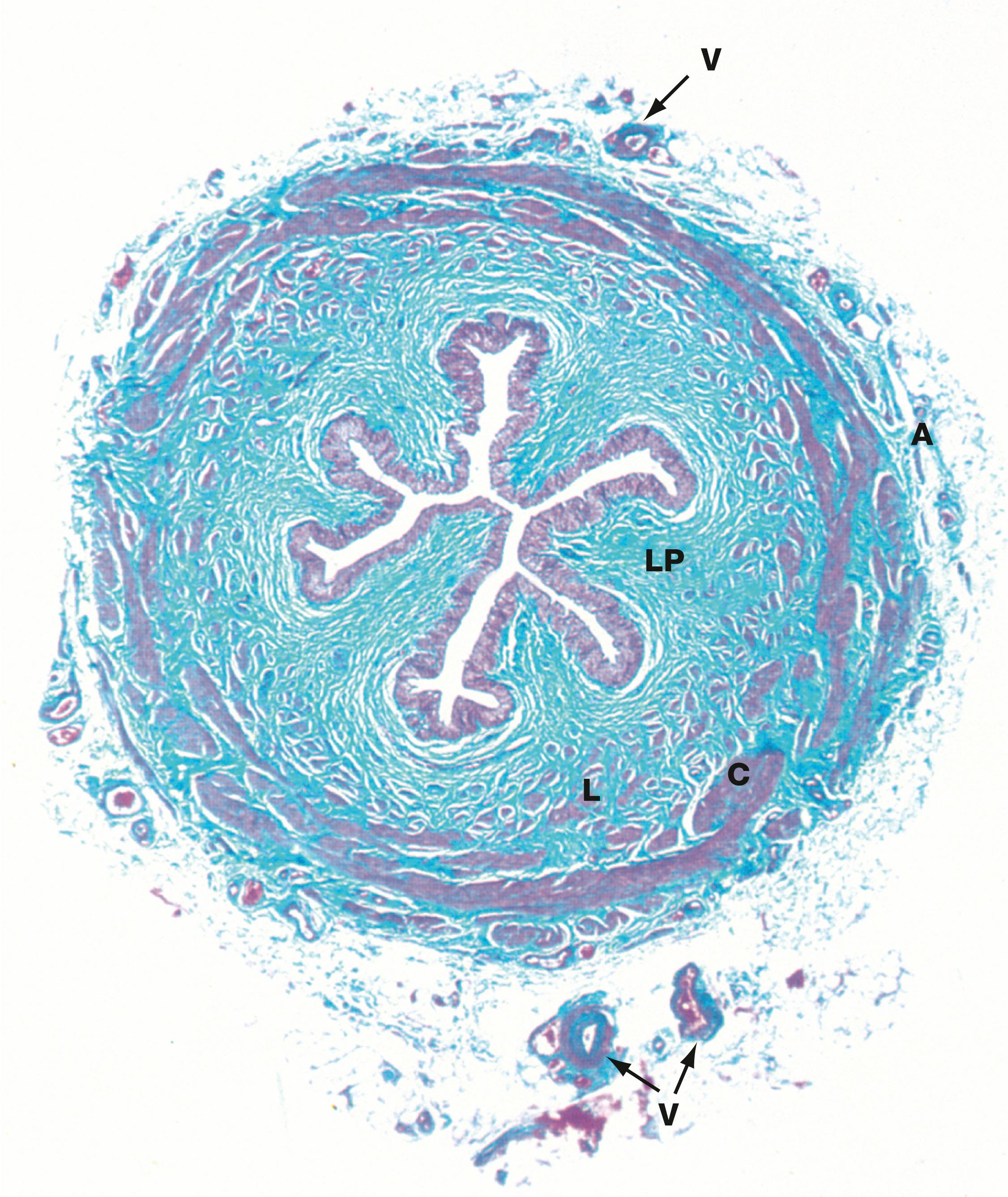
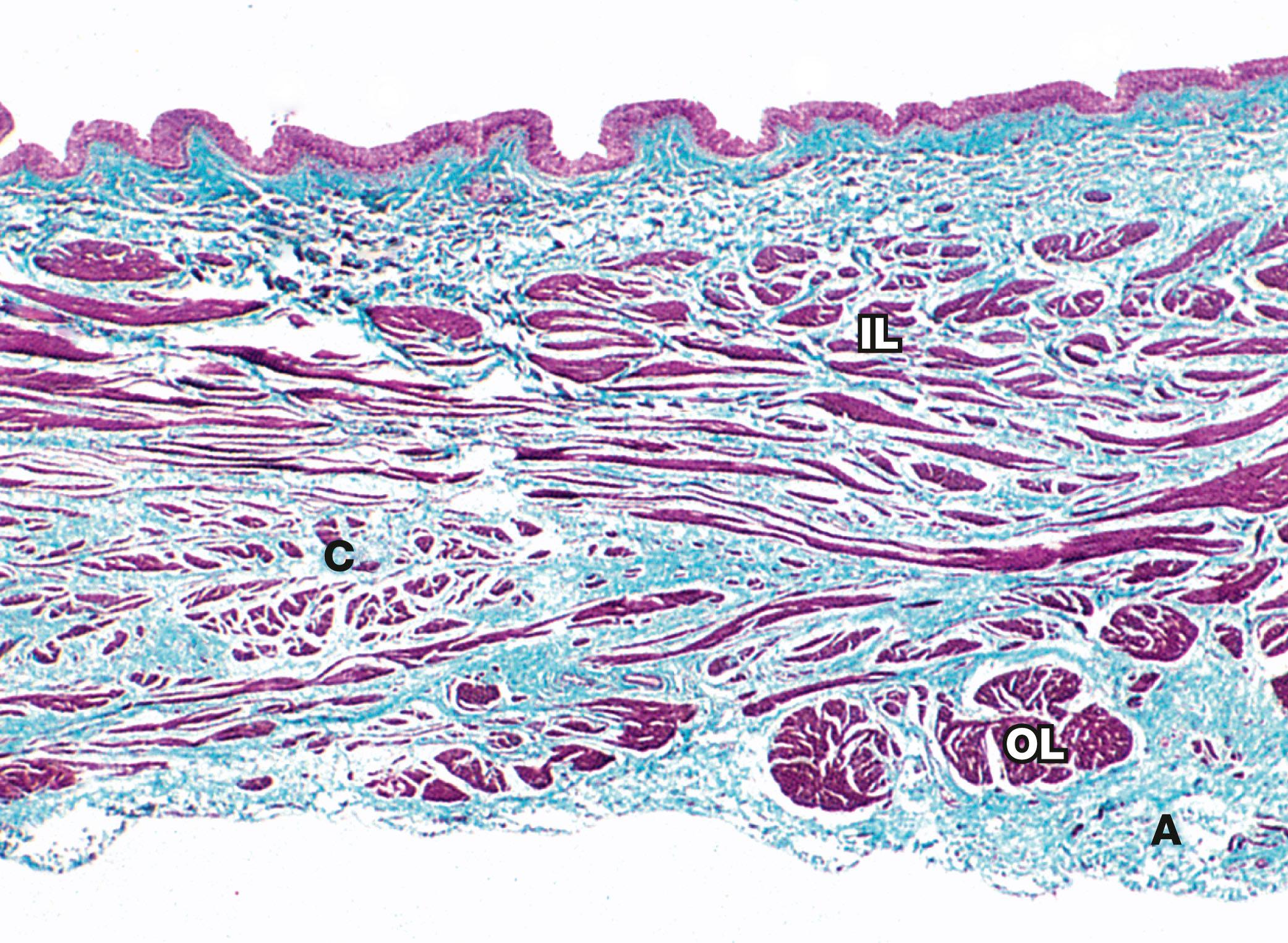
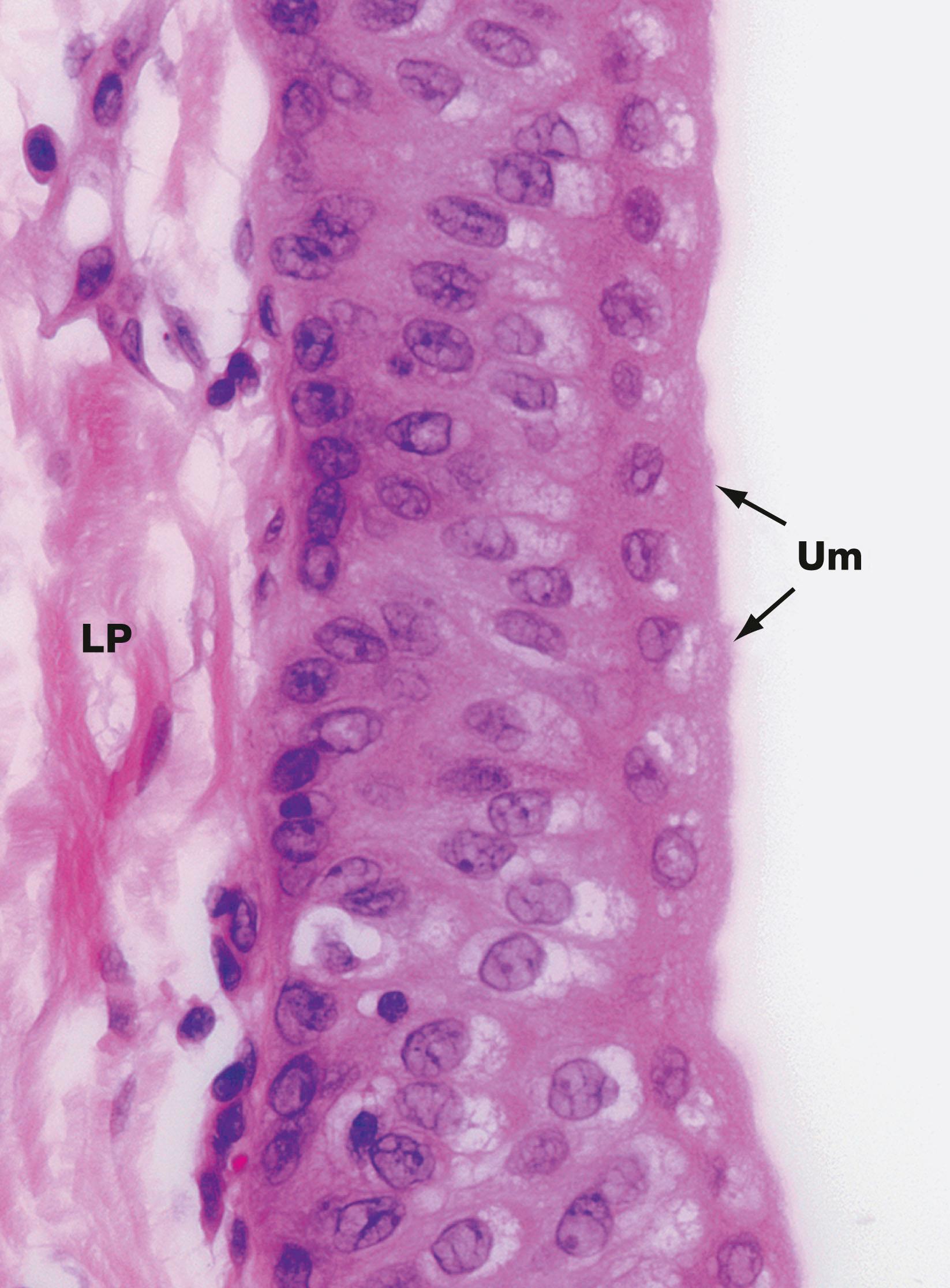
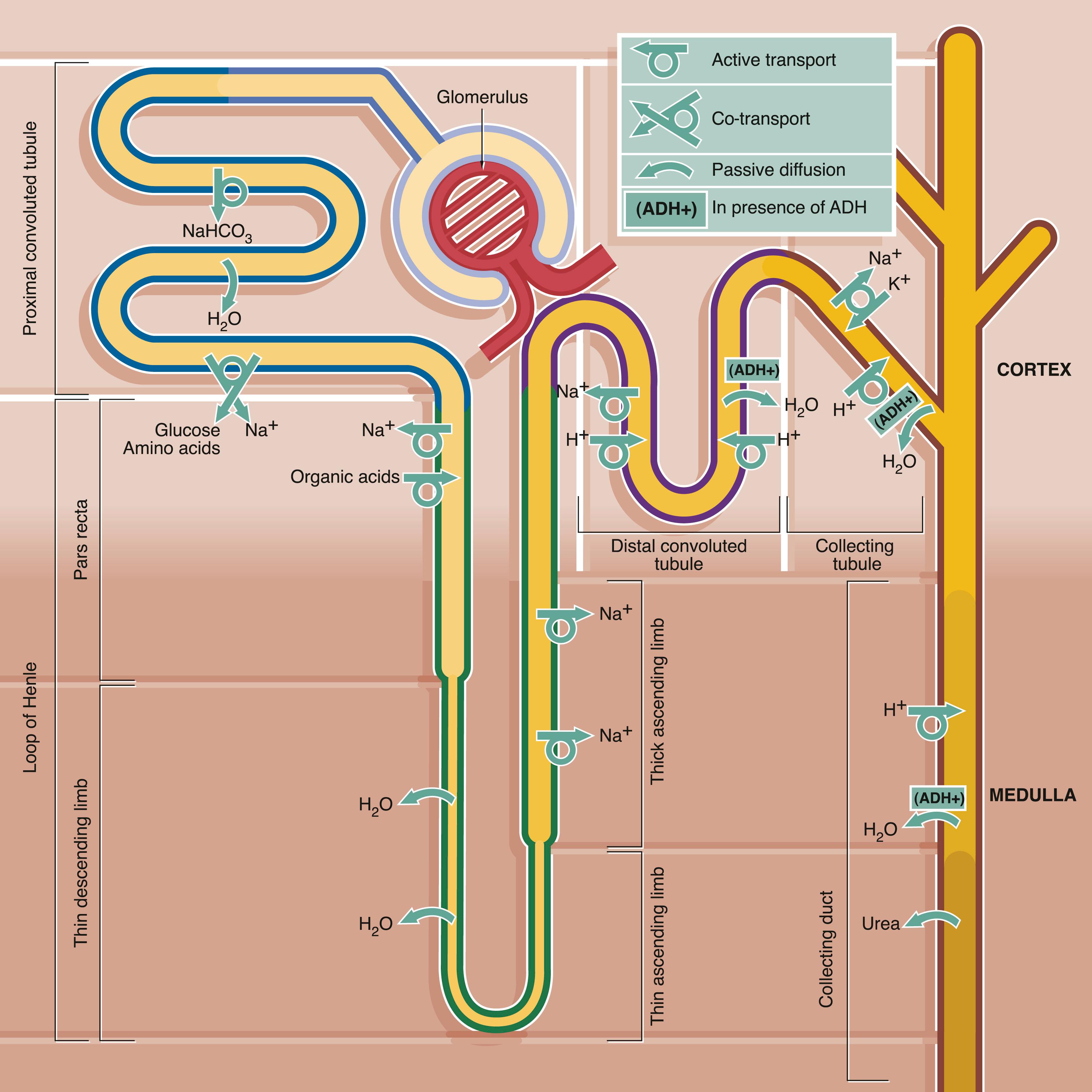
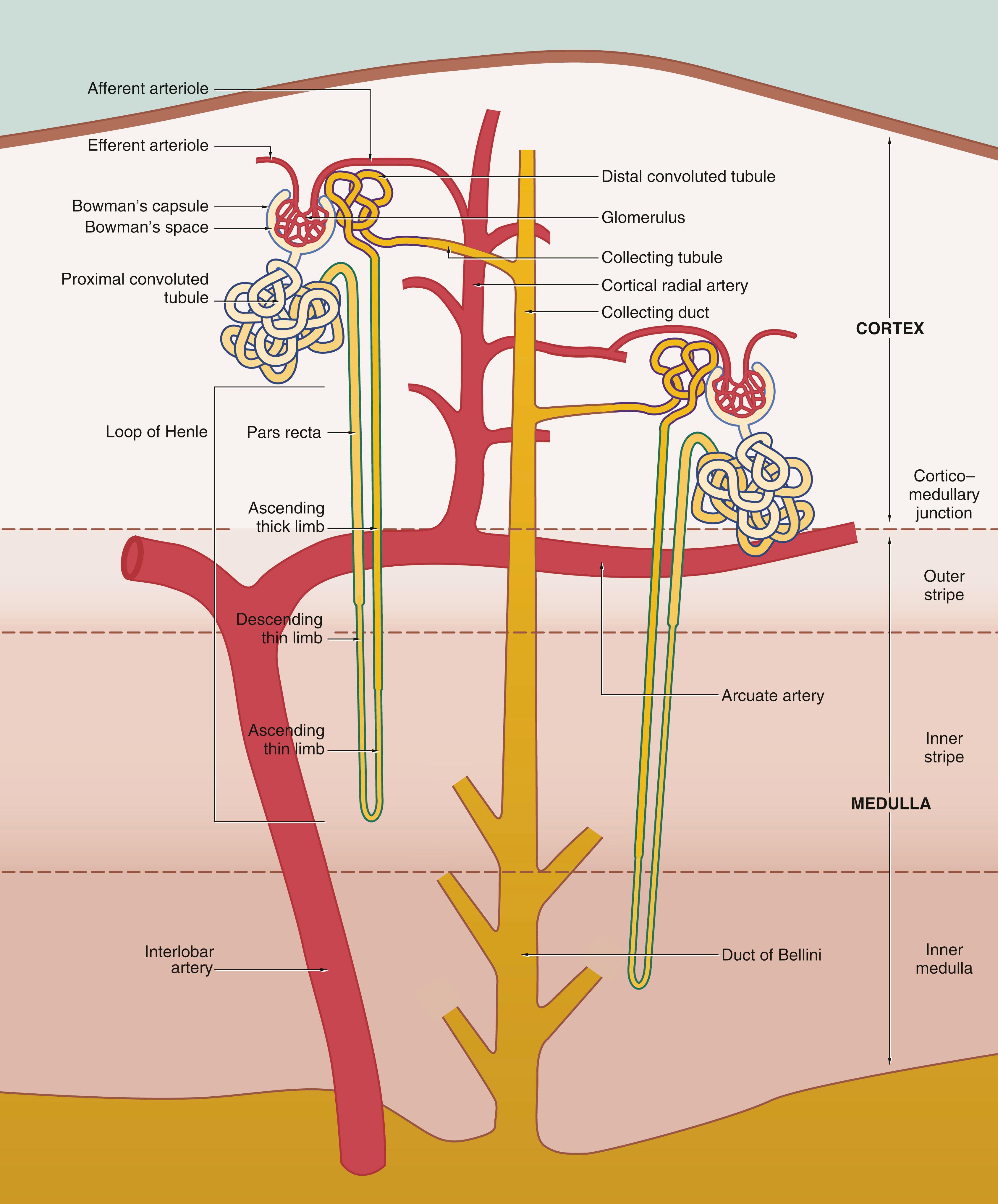
| Kidney | ||||
|---|---|---|---|---|
| Part of nephron | Important structural components | Special features | Functional significance | Figures |
| Glomerulus | Endothelium, glomerular basement membrane and podocytes with foot processes | Glomerular filtration barrier (GFB) | Allow water, ions and small molecules to pass into subpodocyte space while retaining large protein molecules | 16.8 , 16.10–16.15 |
| Juxta-glomerular apparatus | Macula densa of distal convoluted tubule (DCT) | Specialised cells acting as osmoreceptors of DCT, abutting afferent arteriole (AA) | Sensitive to Na + concentration in DCT, indicating reduced BP | 16.18 |
| Juxtaglomerular cells of AA | Modified smooth muscle cells in wall of AA, mechanoreceptors, contain renin | Release renin in response to reduced BP | ||
| Extraglomerular mesangial cells (lacis cells) | Flattened network of mesangial cells abutting macula densa | Role in tubuloglomerular feedback (changes in Na + concentration act to control glomerular flow) | ||
| Proximal convoluted tubule (PCT) | Simple cuboidal epithelium | Microvilli (brush border) | Facilitated diffusion of glucose and amino acids | 16.16 , 16.17 |
| Extensive basolateral interdigitations | Na + pump | |||
| Plentiful mitochondria | Energy for active transport | |||
| Pars recta of proximal tubule | Simple cuboidal epithelium | Microvilli (brush border) | Secretion of organic acids | 16.19 |
| No basolateral interdigitations | ||||
| Thin descending/ascending limbs | Simple squamous epithelium | No basolateral interdigitations or microvilli | No active transport | 16.19 |
| Mitochondria scanty | Low energy requirement | |||
| Thick ascending limb | Simple cuboidal epithelium | Microvilli absent | No facilitated diffusion | 16.19 |
| Extensive basolateral interdigitations | Active transport of Na + | |||
| Distal convoluted tubule (DCT) | Simple cuboidal epithelium | Active transport of Na + | Extensive basolateral interdigitations | 16.16 , 16.17 |
| Mitochondria plentiful | Energy for active transport | |||
| Collecting tubule | Simple cuboidal epithelium | Principal cells | Na + reabsorption, ADH-dependent H 2 O reabsorption, K + secretion | 16.19–16.21 |
| Intercalated cells | Acid–base balance, K + reabsorption | |||
| Collecting tubule cells | ||||
| DCT cells | Active transport of Na + | |||
| Cortical collecting duct | Simple columnar epithelium | Principal cells | Na + reabsorption, ADH-dependent H 2 O reabsorption, K + secretion | 16.20 |
| Medullary collecting duct | Simple columnar epithelium | Mainly principal cells | ADH-dependent water reabsorption | 16.22 |
| Lower urinary tract | ||||
|---|---|---|---|---|
| Component | Muscle structure | Lining epithelium | Function | Figures |
| Pelvicalyceal system | Smooth muscle, no distinct layer structure | Transitional epithelium (urothelium) | Conveys urine from the tips of the renal papillae into the ureter | 16.2 , 16.3 , 16.5 , 16.22 , 16.25 |
| Ureter | 3 muscle layers: inner spiral (longitudinal) and outer spiral (circular) layers and outermost longitudinal layer in lower third | Transitional epithelium (urothelium) | Carries urine to the bladder | 16.1 , 16.2 , 16.23 , 16.25 |
| Bladder | 3 muscle layers: inner and outermost longitudinal and middle circular | Transitional epithelium (urothelium) | Stores urine | 16.1 , 16.24 , 16.25 |
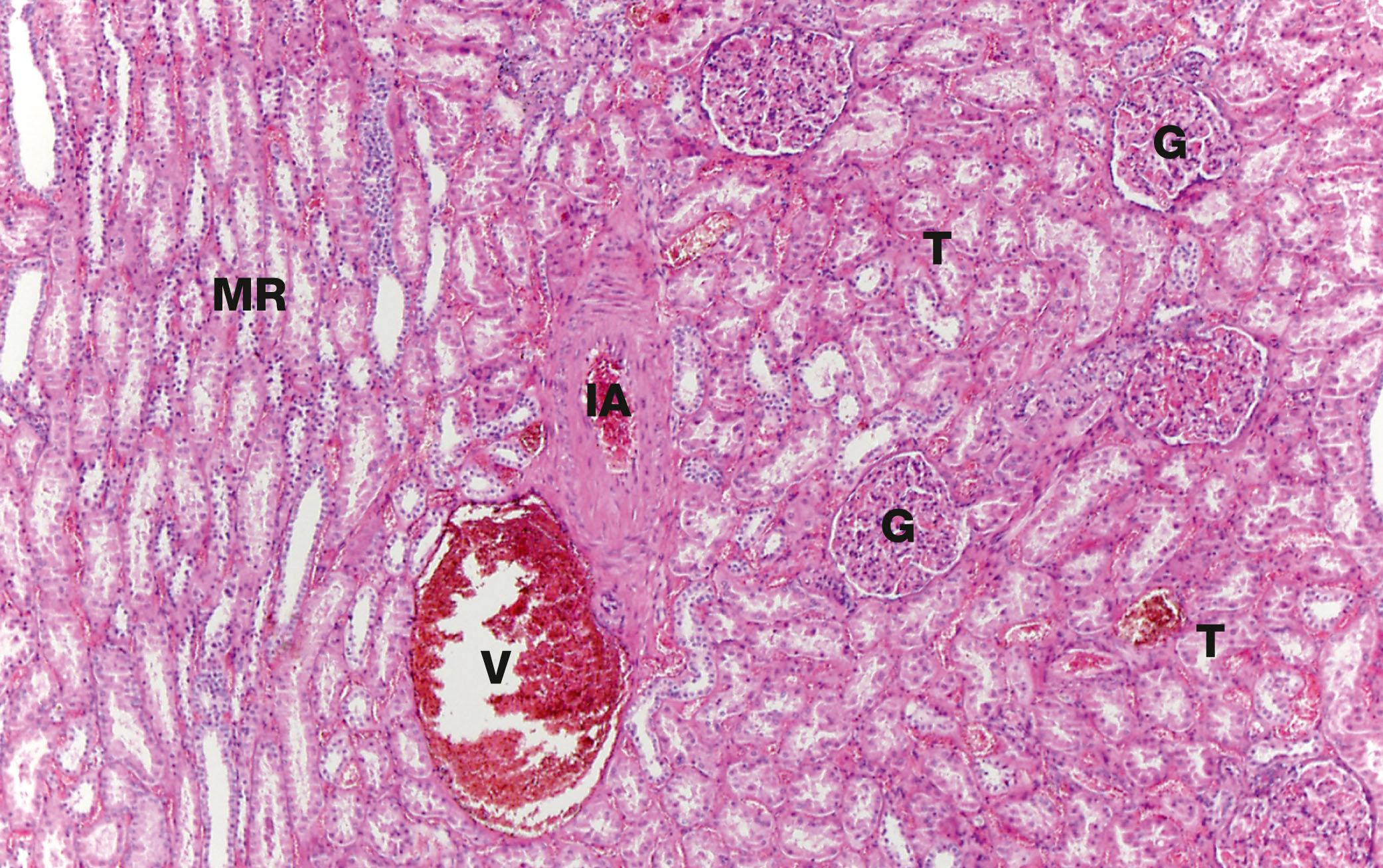
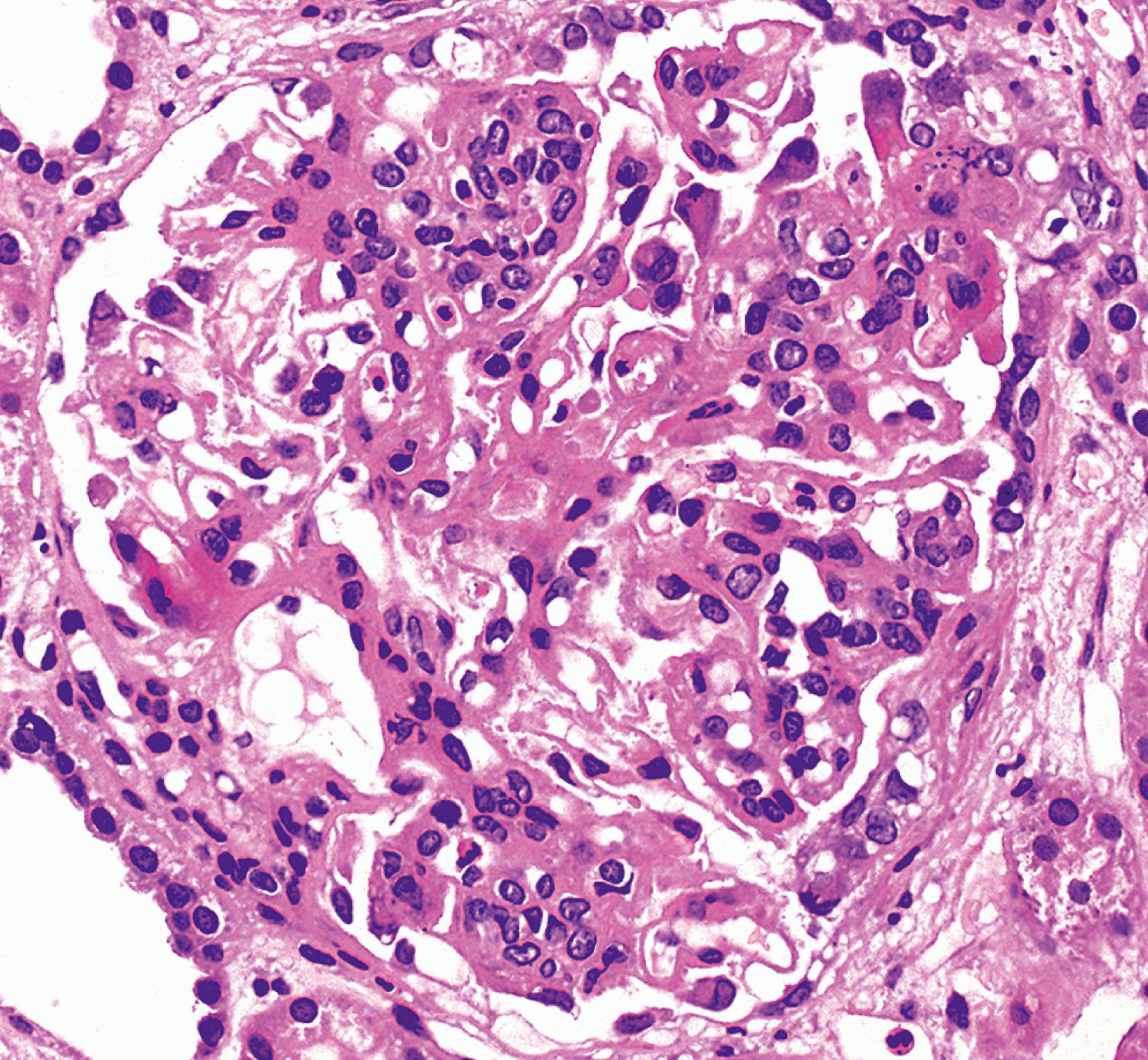
Become a Clinical Tree membership for Full access and enjoy Unlimited articles
If you are a member. Log in here